Thinking beyond the usual deck planks can unlock dozens of ways to make a gazebo floor safer, longer-lasting, and far more eye-catching. From classic pressure-treated boards to futuristic aluminum panels, the 20 ideas below explore materials that handle rain, sun, and foot traffic while boosting comfort and style. Each paragraph explains why the option works, how it is installed or maintained, and what unique bonus—drainage, eco-cred, slip resistance, or dramatic texture—it brings to your outdoor retreat. Use them as mix-and-match inspiration or a direct blueprint for the gazebo floor that best fits your climate, budget, and aesthetic goals.
1. Pressure-Treated Wood Gazebo Floor Deck

A timeless pressure-treated wood gazebo floor delivers affordability and familiarity while resisting insects and decay thanks to kiln-dried-after-treatment pine boards. Southern yellow pine’s dense grain withstands heavy benches and grill stations, and routine sealing keeps splinters at bay. Because the material arrives pre-cut in common 1×6 or 5/4×6 sizes, installation mimics a standard deck, making it a strong DIY choice. Lay joists 16 inches on center, gap boards ⅛ inch for drainage, and anchor post bases through the floor into concrete piers to prevent racking in storms. Annual washing and a fresh coat of semi-transparent stain preserve color while allowing the gazebo floor’s natural wood warmth to shine.
2. Composite Decking Gazebo Floor for Low Upkeep
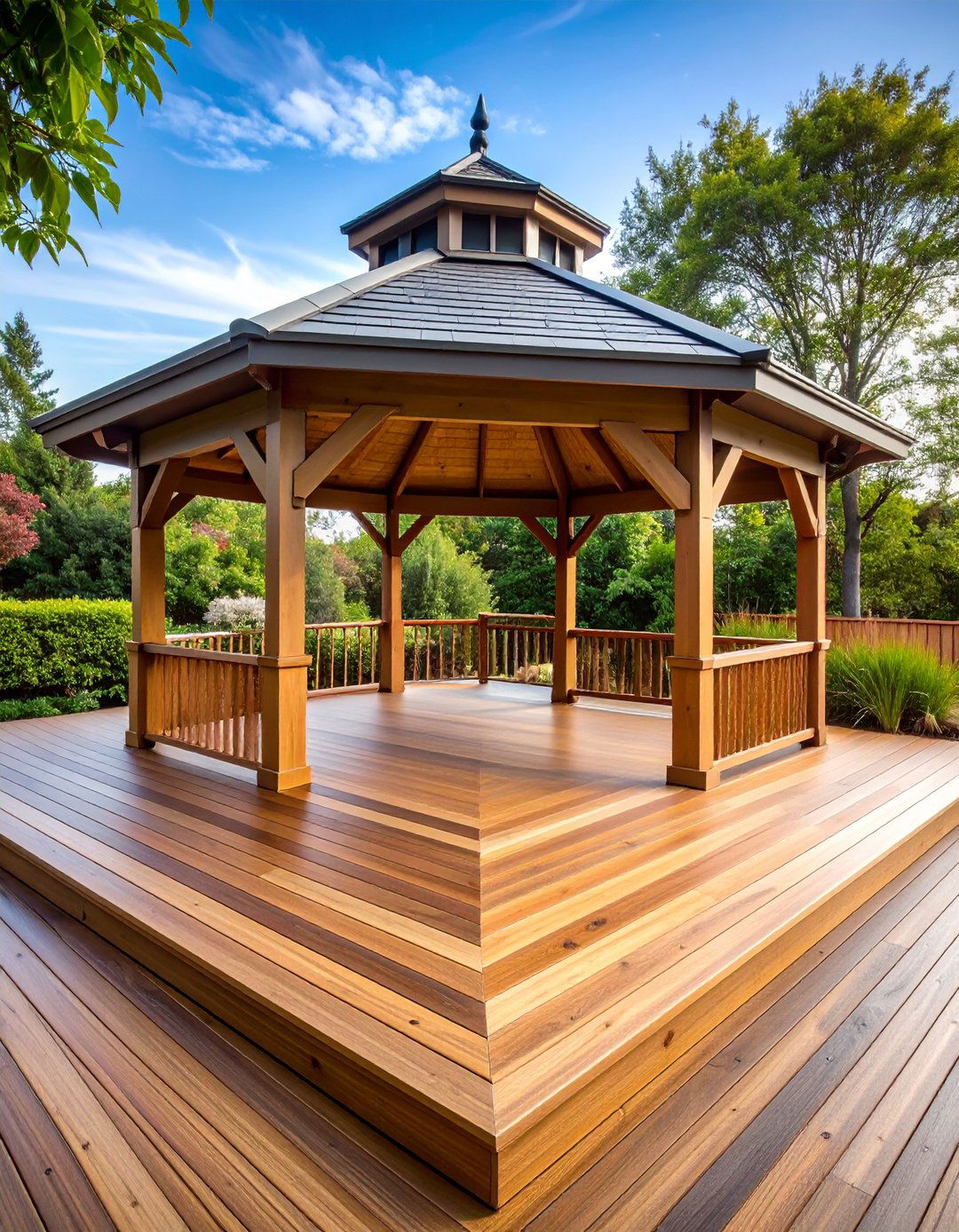
Composite decking merges recycled plastics with wood fibers to create a gazebo floor that shrugs off rot, splinters, and repainting chores. Modern boards come in slip-resistant textures that mimic oak, ipe, or driftwood gray while concealing hidden-clip fasteners for a clean surface. A simple soap-and-water rinse removes dirt, and fade-resistant pigments handle years of direct sun without graying. Though the initial outlay is higher than pine, composite needs no sanding or sealing, saving weekend labor and long-term costs. Match fascia and railing trim for a polished look, and use manufacturer-approved stair treads so every element of the gazebo floor stays maintenance-free.
3. Natural Flagstone Gazebo Floor Patio
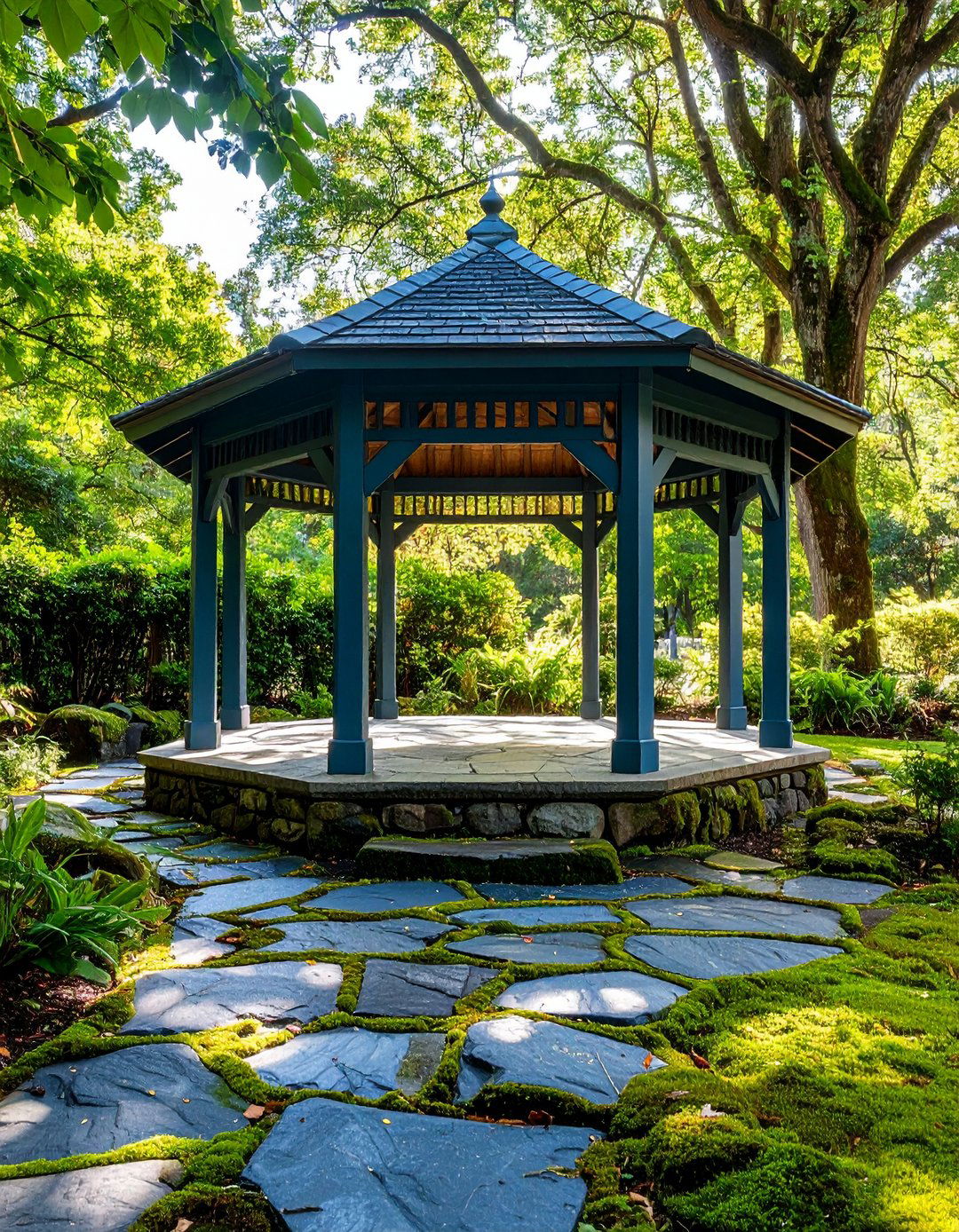
Nothing beats the organic character of a flagstone gazebo floor, where irregular slabs of sandstone or bluestone settle into a compacted base and lock together like a puzzle. The broad joints funnel rain into the soil, minimizing puddles, while the stone’s coarse face stays grippy even when wet. Select pieces at least 1½ inches thick to prevent cracking under dining-set legs, and tamp each stone into a 3-inch bed of crushed gravel and stone dust for stability. Moss or polymeric sand in the gaps can soften the look or tighten it for weed control. With only periodic sweeping, the surface weathers gracefully, blending the gazebo floor into the surrounding garden.
4. Stamped Concrete Gazebo Floor Slab
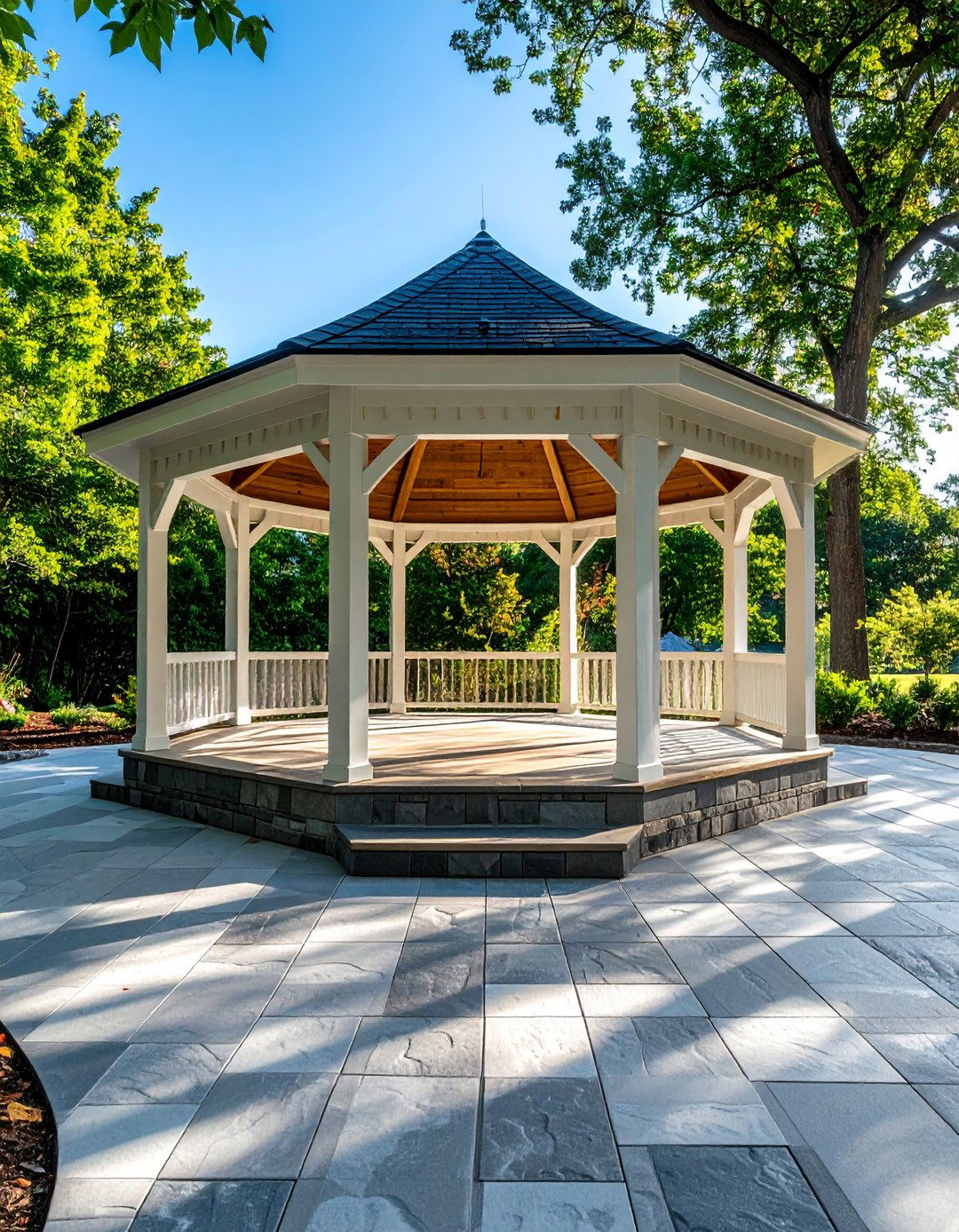
For a seamless gazebo floor that mimics slate or wood yet pours as a single monolith, opt for stamped concrete colored integrally or with release powders. Deep stamp textures add traction, and mixing a non-skid additive into the sealer curbs slipperiness without dulling the pattern. A 4-inch slab reinforced with rebar eliminates joist squeaks and supports outdoor kitchens with ease. Control joints cut in a radial pattern beneath the gazebo hide future hairline cracks. Re-sealing every three to five years revives gloss and protects pigments, giving you a durable, designer gazebo floor that shrugs off chair scrapes, embers, and muddy paw prints.
5. Herringbone Brick Gazebo Floor Pattern
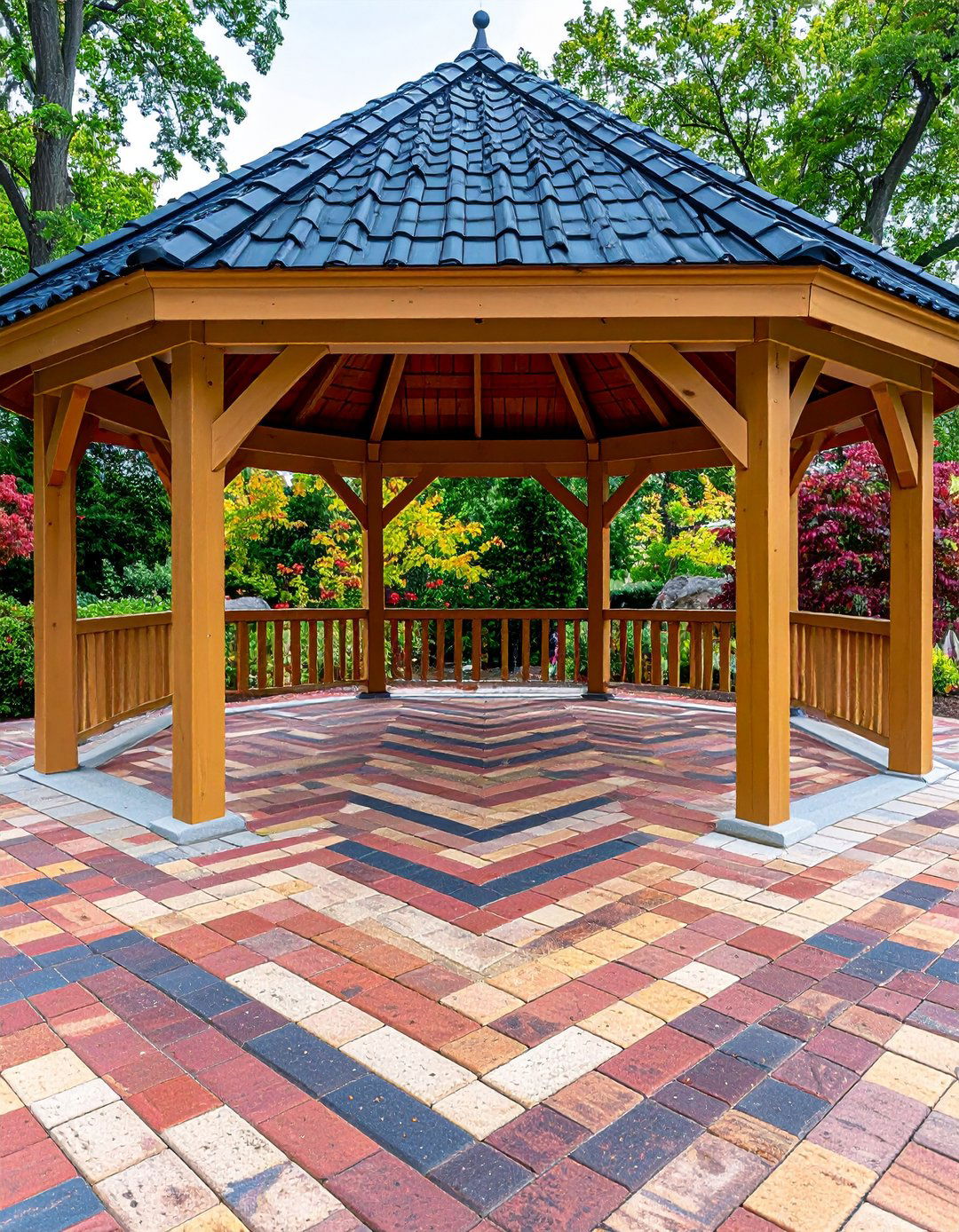
A herringbone brick layout lends old-world charm and superb interlock strength to a gazebo floor. Setting modular pavers at 45 degrees distributes foot traffic across multiple joints, resisting shifting on freeze-thaw soils. Start with a gravel base, screed a 1-inch sand layer, then kneel boards to maintain straight course lines. Edge restraints prevent spreading, and sweeping polymeric sand into the joints locks bricks tight and deters weeds. Sealers boost color and repel stains from barbecue spills. The result is a richly textured gazebo floor that feels as solid as a city sidewalk yet looks like it has been part of the landscape for decades.
6. Interlocking Deck-Tile Gazebo Floor

If you need an instant makeover over concrete or a tired deck, snap-together deck tiles turn a gazebo floor into a weekend project. Modular squares made from acacia wood or WPC composite clip together with hidden teeth, requiring no nails or glue. The elevated profile lets rain drain underneath, drying boards quickly and protecting the substrate. Mix wood-look tiles with slate or pebble inserts to define zones inside larger pavilions. When boards weather, simply unclip a damaged tile and swap it out—ideal for renters or seasonal cottages. Light oiling once a year keeps natural wood versions vibrant and splinter-free.
7. Pea Gravel Gazebo Floor with Stepping Stones
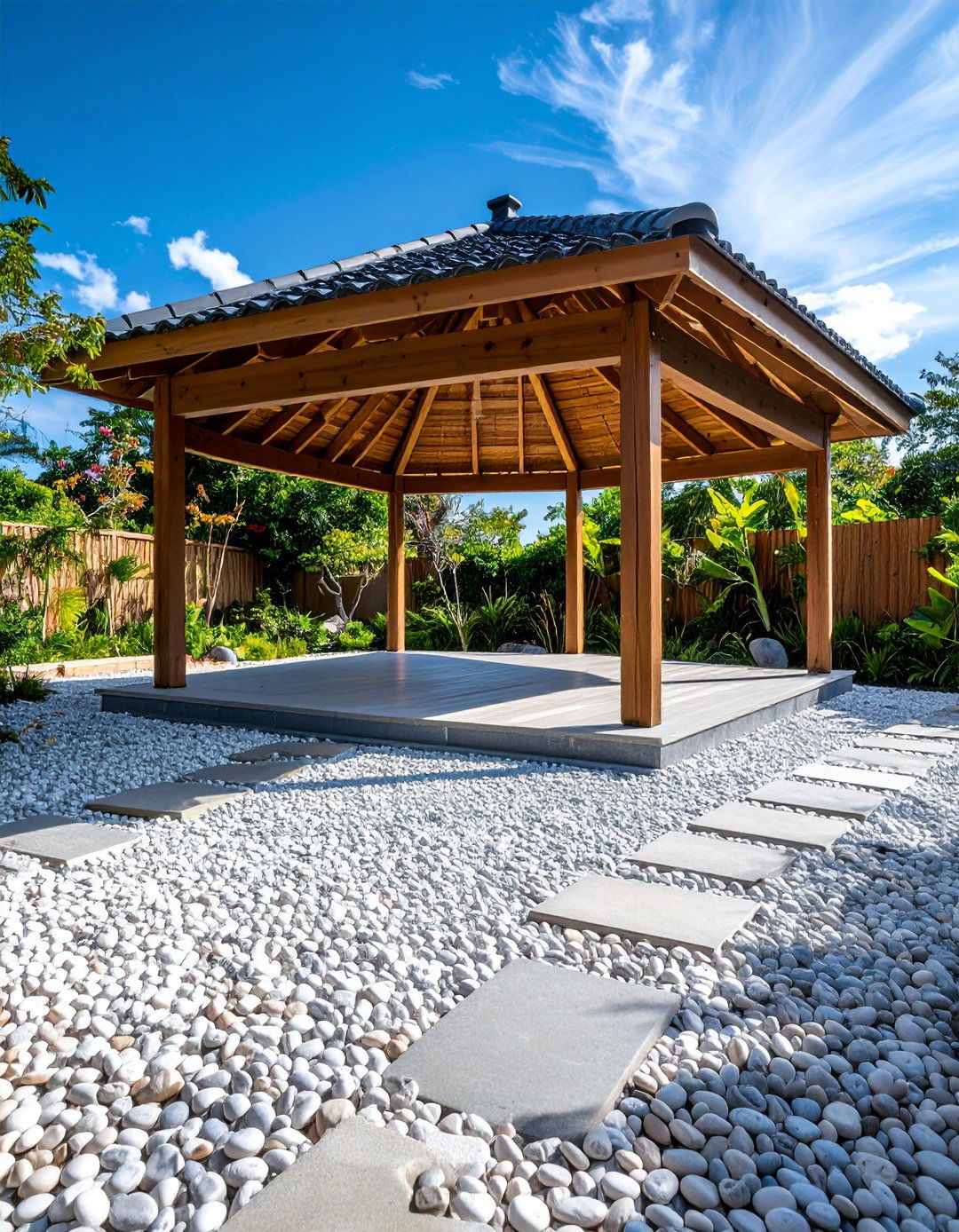
A pea gravel gazebo floor offers the breezy informality of a Mediterranean courtyard while costing far less than pavers. Because the rounded stones settle into themselves, they provide excellent drainage and reduce mud splatter. Contain the perimeter with metal edging, compact a 3-inch crushed-stone base, then spread two inches of gravel stabilized by honeycomb grids if you want to roll furniture easily. Stepping-stone slabs embedded flush with the surface create stable landing pads for chairs and accent tables. Occasional raking smooths footprints, and a top-up bag every couple of seasons freshens color, giving the gazebo floor a relaxed, beach-pebble vibe.
8. Slip-Resistant Porcelain Tile Gazebo Floor
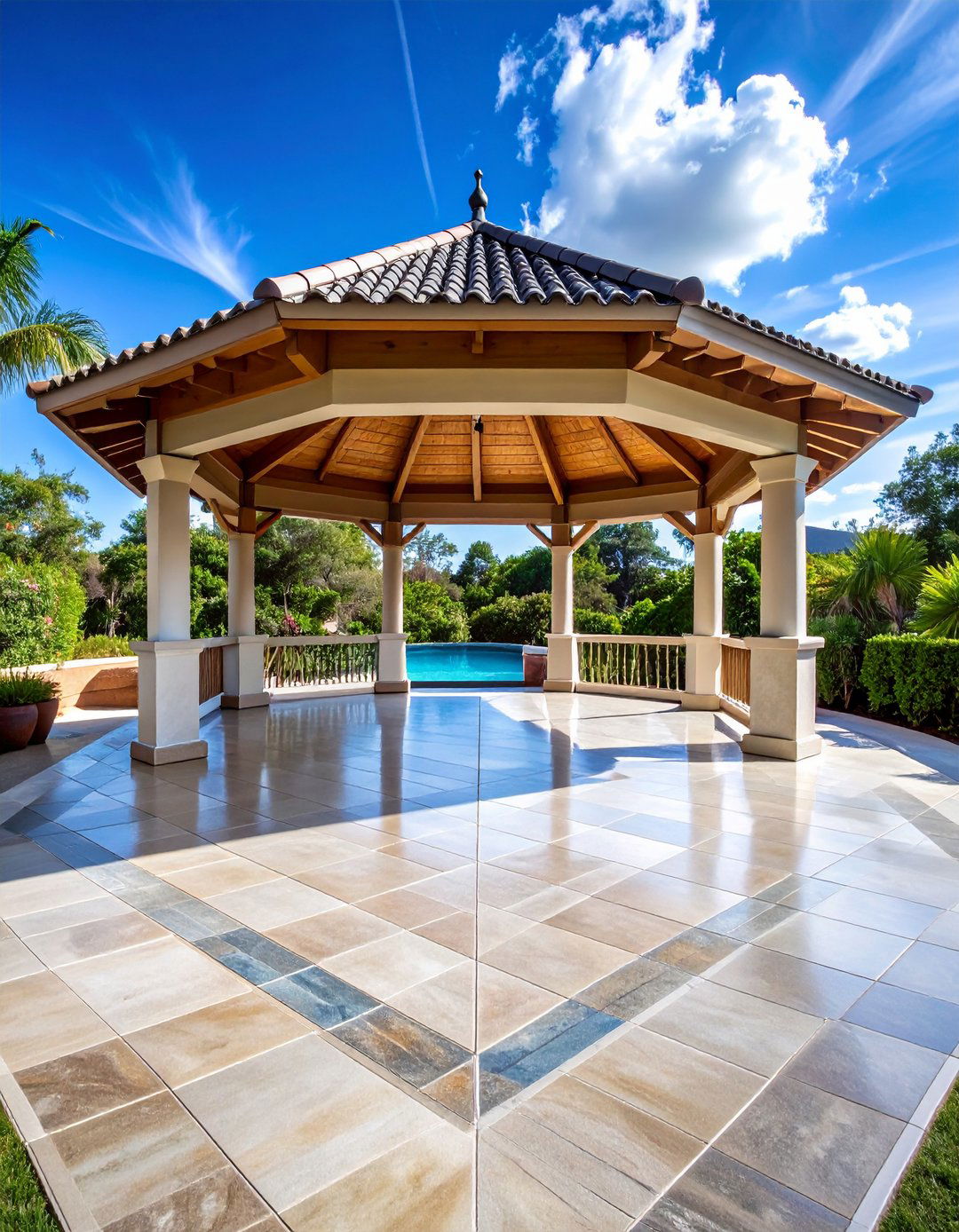
For sleek style without slippery surprises, outdoor-rated porcelain tiles incorporate micro-grit glazing that tests 50 percent more slip-resistant than standard tile. The fired-clay body resists frost, fading, and barbecue grease, making it a premium yet worry-free gazebo floor. Install over a concrete slab with flexible exterior thin-set and grout with a polymer additive to handle movement. Wood-plank porcelain lets you enjoy barn-board aesthetics where termites would otherwise feast, while large-format stone looks minimize grout lines for easy sweeping. A pH-neutral cleaner and annual grout sealer keep this gazebo floor looking showroom-fresh year after year.
9. Bamboo Gazebo Floor Boards
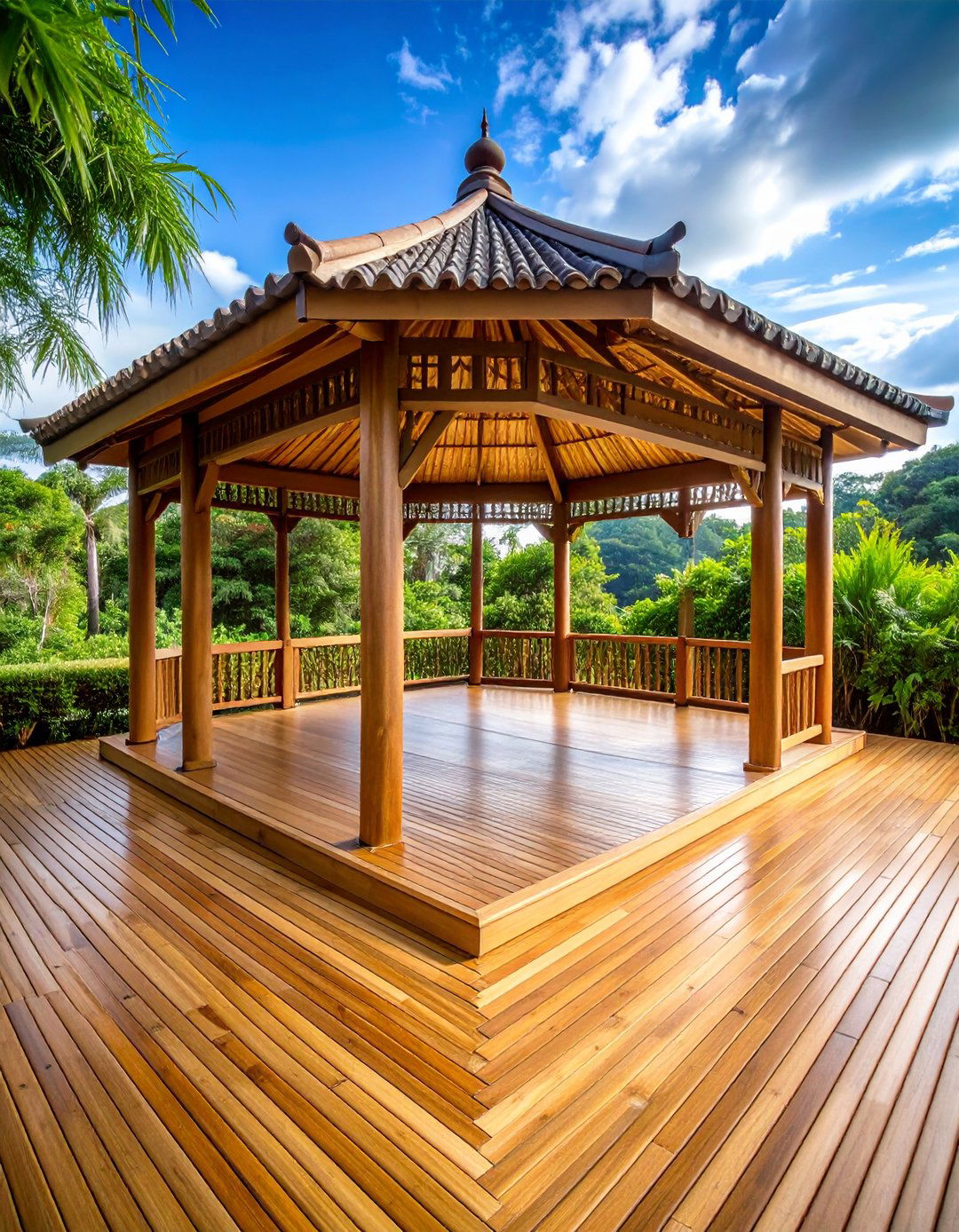
Thermally modified and compressed bamboo boards rival tropical hardwoods in hardness yet come from a rapidly renewable grass, giving eco-minded homeowners a guilt-free gazebo floor. The strand-woven structure minimizes swelling, and factory oils impregnate fibers for decades of rot resistance. Install with hidden clips on stainless screws, leaving ¼-inch expansion gaps around posts. Bamboo can be left to weather a silvery gray or oiled twice annually to deepen chocolate tones. Because it is denser than oak, pre-drill end cuts to avoid splitting. The result is a luxe, sustainable floor that pairs modern lines with a natural palette.
10. Recycled Rubber Paver Gazebo Floor
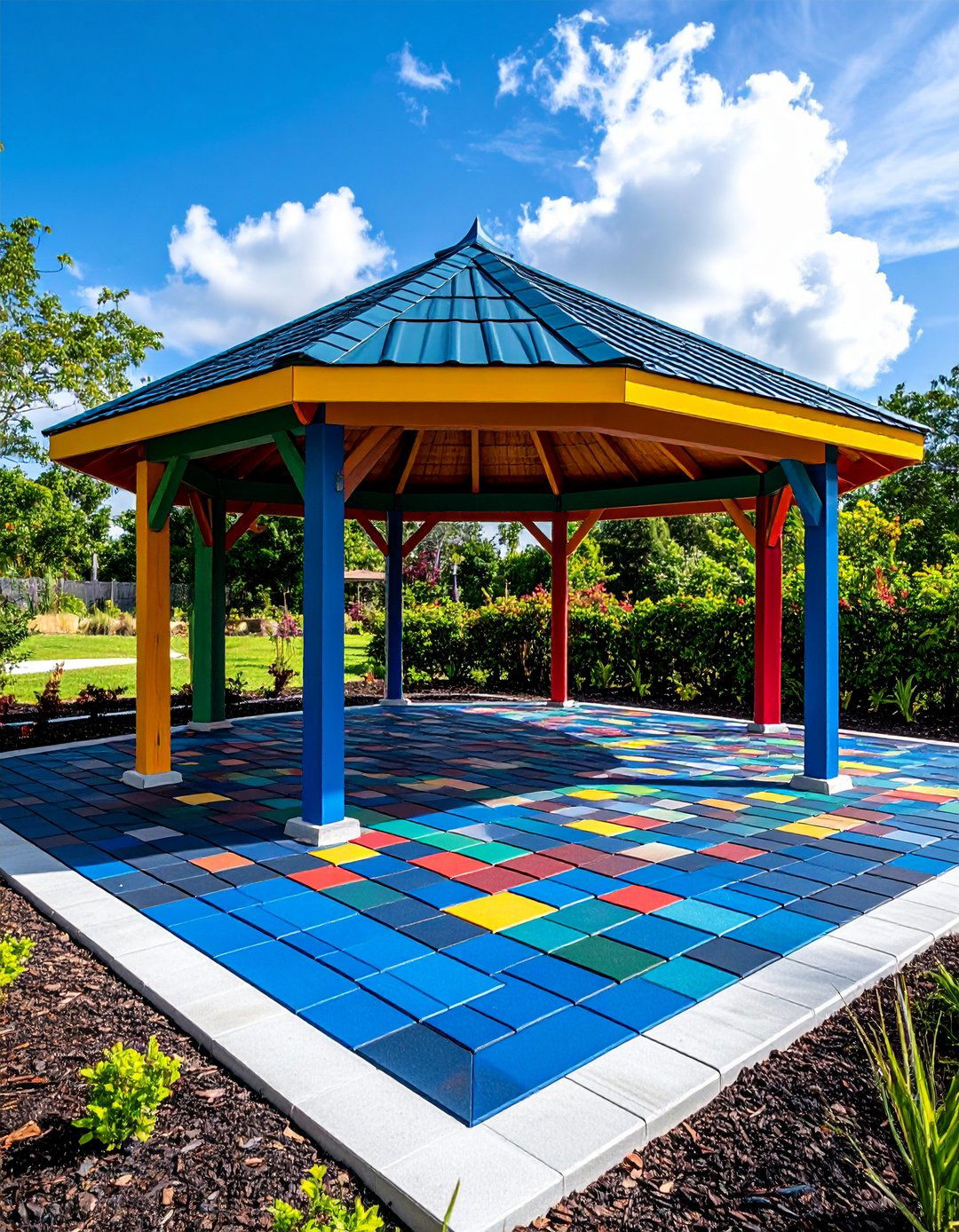
Made from shredded tires, recycled rubber pavers cushion joints and deaden the clang of patio furniture—a smart gazebo floor where kids tumble or yoga mats unroll. The blocks interlock or glue to concrete, forming a porous surface that channels rain away while staying slip-resistant even when wet. Color pigments resist fading, and the resilient texture hides small cracks in the slab below. Hose it off or use a mild detergent for deeper cleans. Because the tiles are lightweight and cut with a utility knife, complex gazebo footprints install quickly without power saws or masonry dust.
11. Scored & Stained Concrete Gazebo Floor
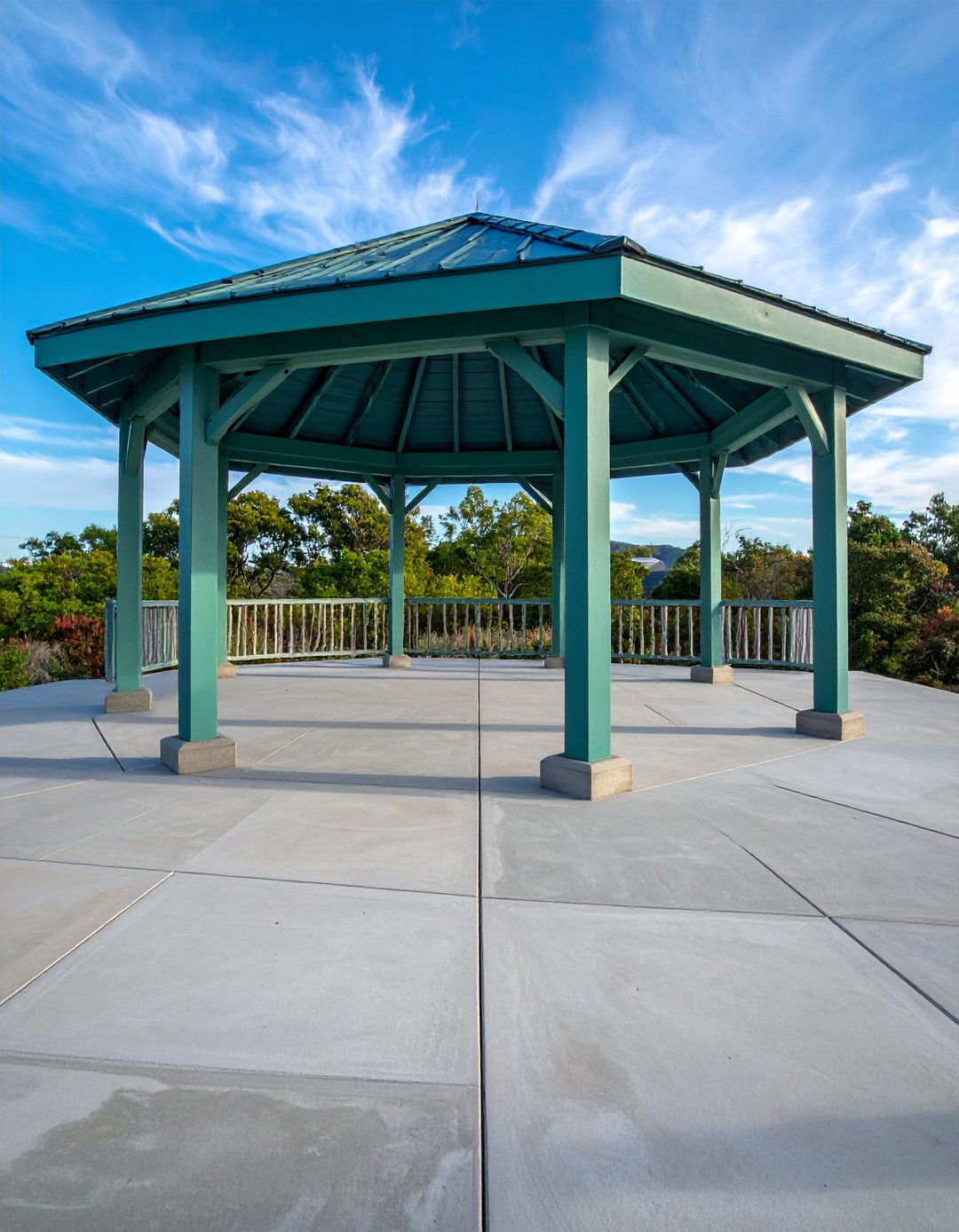
Transform a plain slab into a high-end gazebo floor by scoring a pattern of 2-foot squares with a circular saw and diamond blade, then flooding the surface with water-based stains that create marbled depth. Homeowners report dramatic before-and-after makeovers with simple masking-tape grids and mottled color layers. After neutralizing and rinsing, seal with a UV-stable acrylic to lock in hues and add a subtle sheen. Unlike tile, there are no grout lines to scrub, and the score-cuts act as control joints that minimize visible cracking. Reapply sealer every few years to refresh gloss and keep the gazebo floor art-gallery-worthy.
12. Artificial Turf Inlay Gazebo Floor
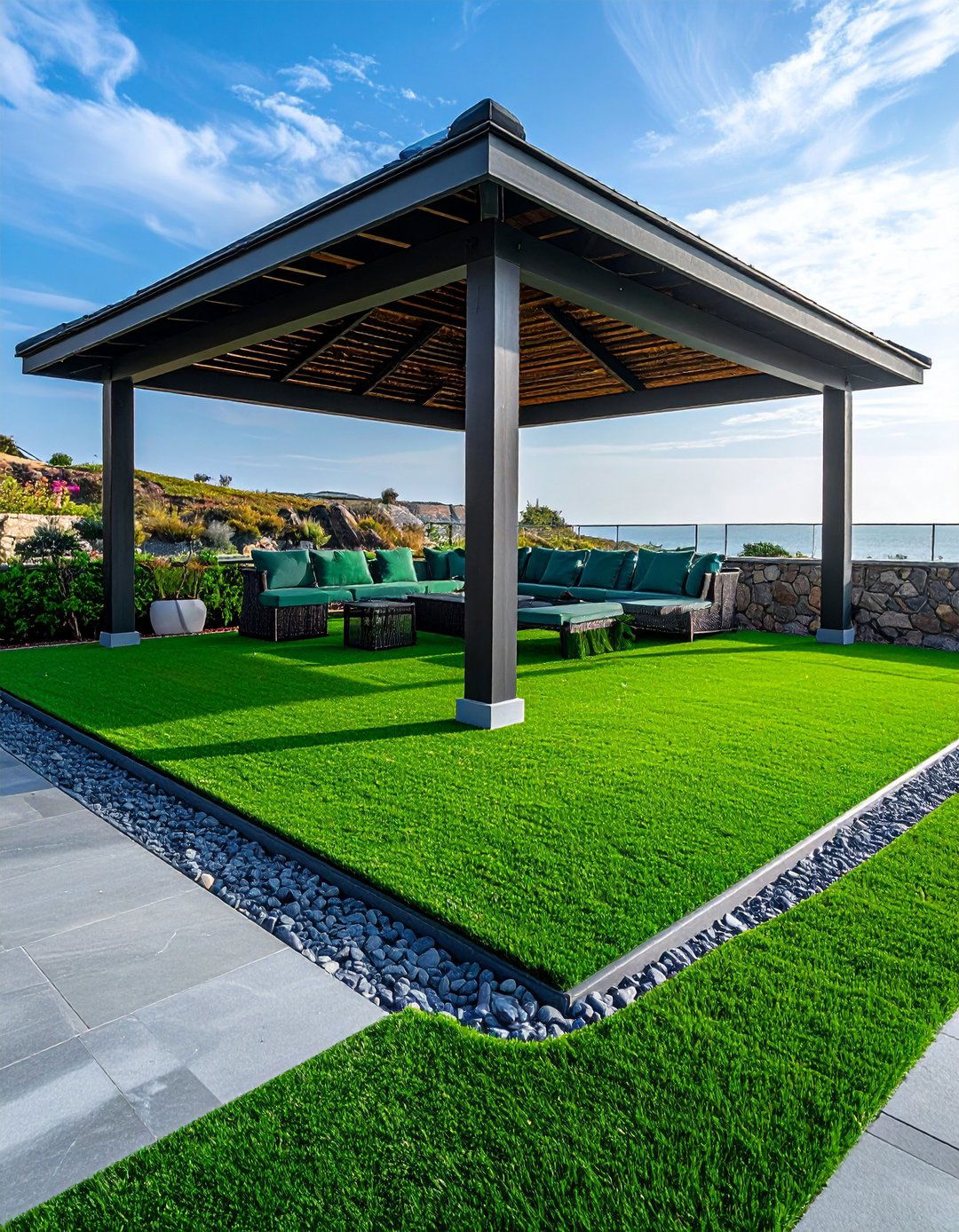
Incorporating strips or tiles of artificial grass softens hardscaping and invites barefoot lounging inside the gazebo. Modern polyethylene turf resists UV fade, drains through perforated backings, and lies atop a compacted stone base or click-together deck panels. Frame turf panels with stone or composite borders to define lounging zones and keep pile edges tidy. Brush infill sand periodically to stand fibers upright and rinse spills with a garden hose. The lush, always-green gazebo floor doubles as a play mat for pets and kids, delivering the look of a mini lawn without mowing or mud.
13. Reclaimed Timber Plank Gazebo Floor
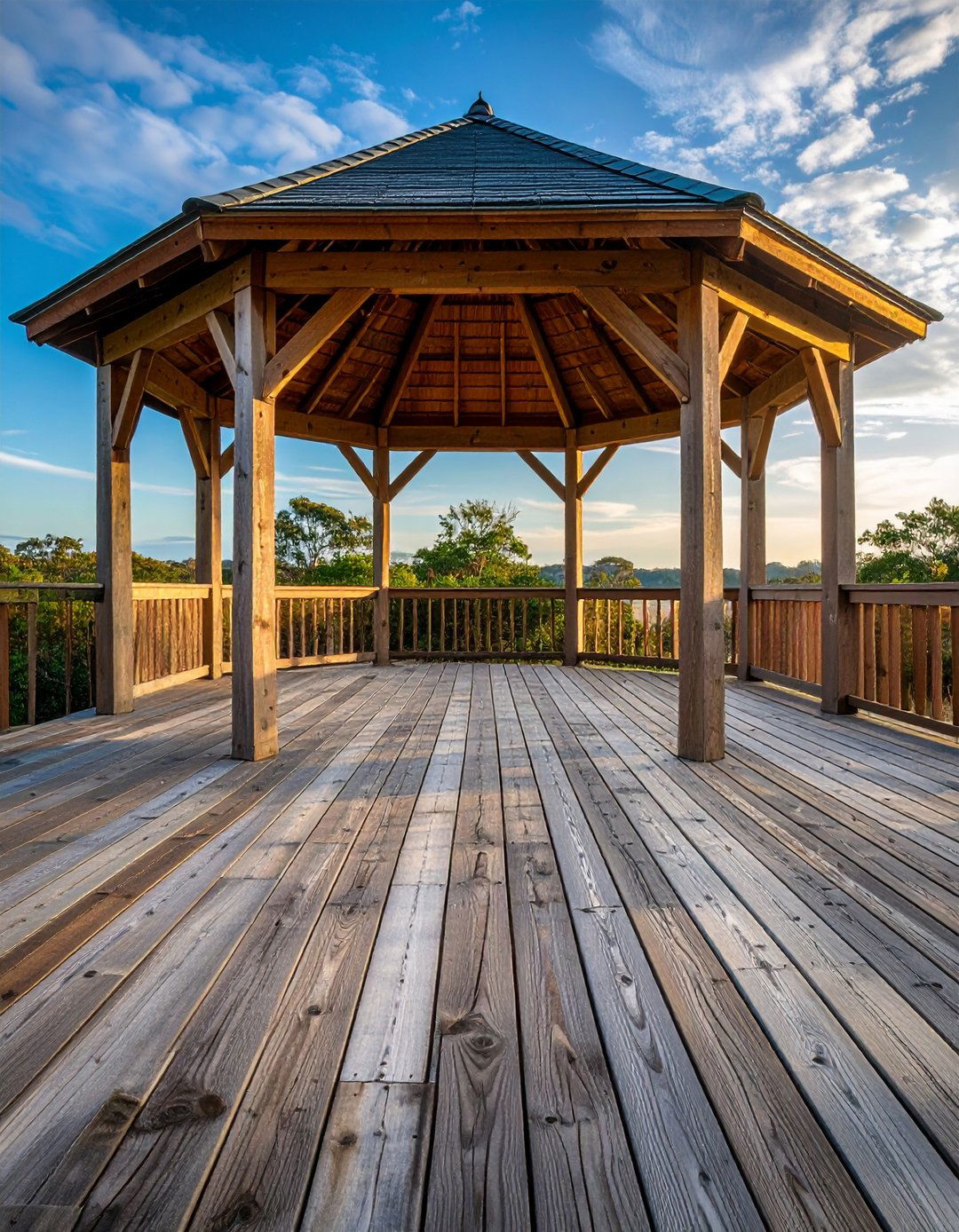
For rustic soul and sustainability, salvage barn beams or reclaimed ironwood planks and mill them into decking that tells a story. Weathered boards develop a silvery patina that blends seamlessly with rural landscapes while reducing landfill waste. Because older timbers often contain tight growth rings, they resist warping; nonetheless, kiln-dry and re-grade each piece, then pre-drill and face-screw with stainless hardware. Fill historic nail holes with epoxy to keep toes safe. Finish with a penetrating oil that highlights grain but lets the gazebo floor continue aging gracefully, adding authenticity no new lumber can match.
14. Permeable Paver Gazebo Floor for Stormwater Control
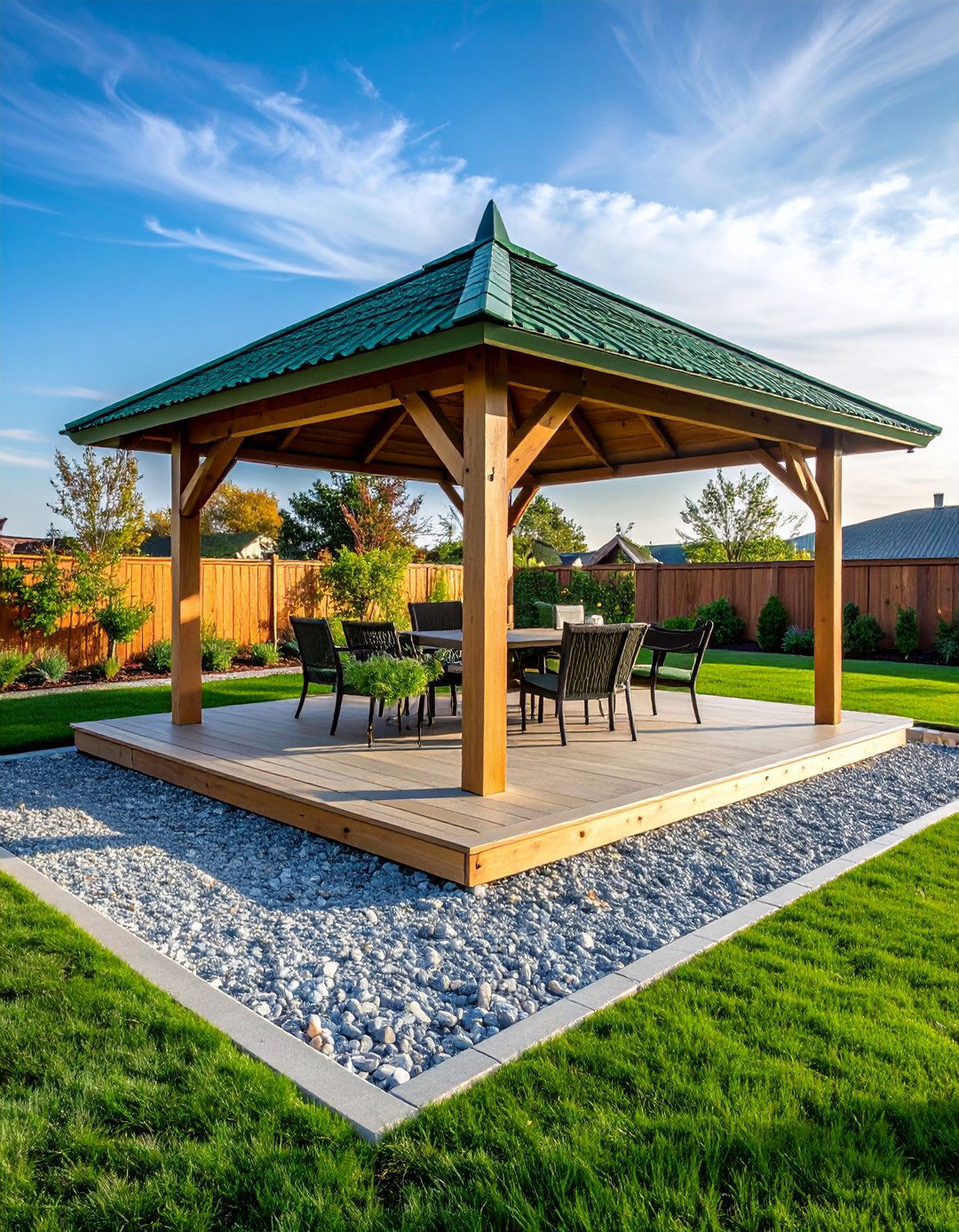
When runoff is a concern, permeable concrete or turf-block pavers create a gazebo floor that soaks up rain like a sponge, sending water back to groundwater rather than overloading drains. Wide joints packed with gravel or grass channels handle heavy downpours while meeting many local low-impact-development codes. Underlay the grid with a reservoir of angular stone, and compact layers to retain structural support. The voids capture pollutants, and occasional vacuuming removes sediment. Pair with native plantings around the perimeter to craft a high-functioning, eco-friendly relaxation hub.
15. Gravel Stabilization Grid Gazebo Floor
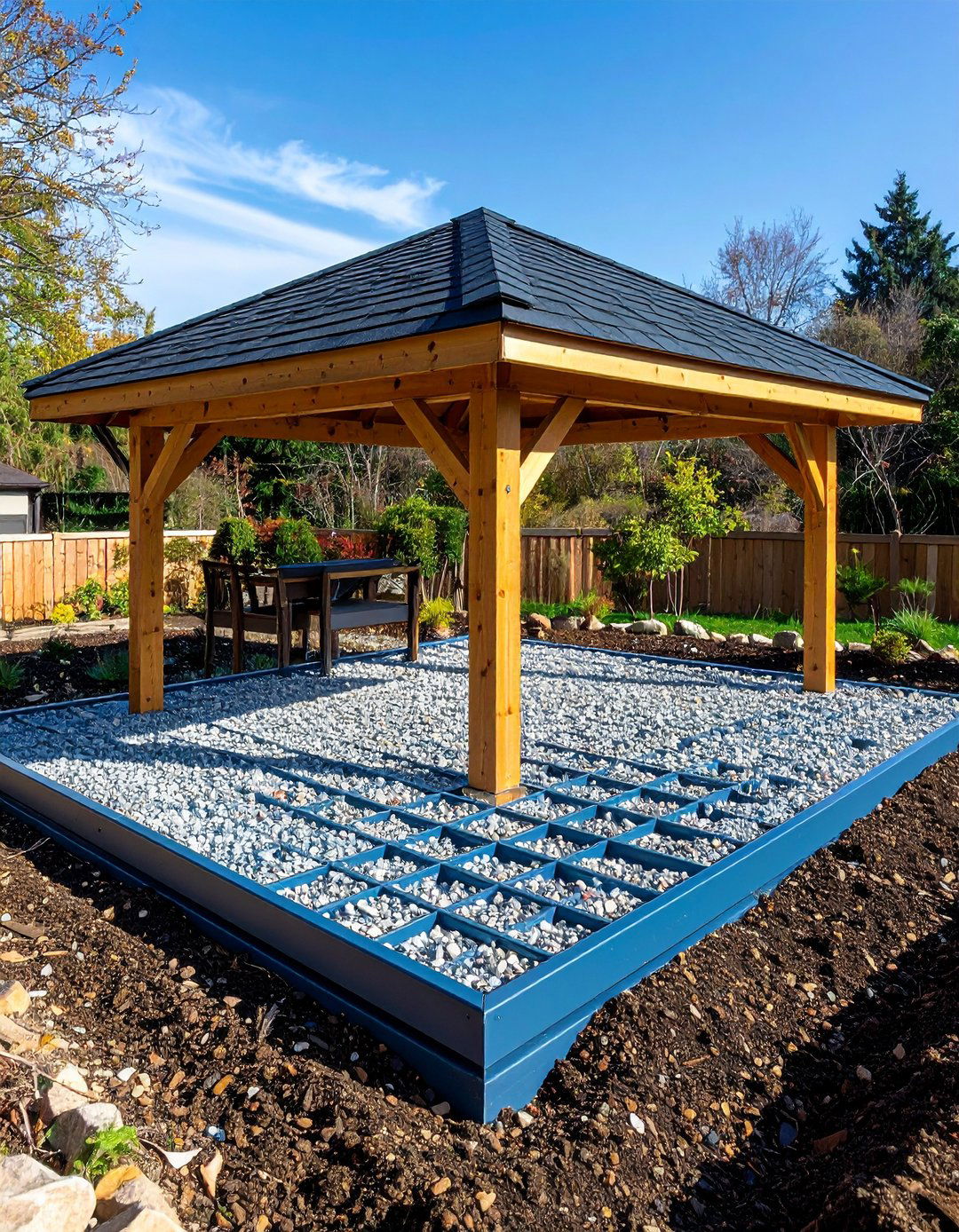
Plastic geo-cells filled with pea gravel fuse the free-form look of loose stone with the firm footing of a paved path—a clever compromise for gazebo floors on slopes. The honeycomb lattice spreads loads up to 1,800 lb / sq ft, preventing ruts and washouts under chair legs. Roll out the panels over leveled sub-base, anchor with landscape staples, then sweep gravel until flush. The invisible reinforcement lets you push a wheelbarrow or roll a cooler without bogging down, and any displaced stones rake back easily. Weed fabric below curtails sprouts, keeping upkeep low.
16. Exposed Aggregate Concrete Gazebo Floor
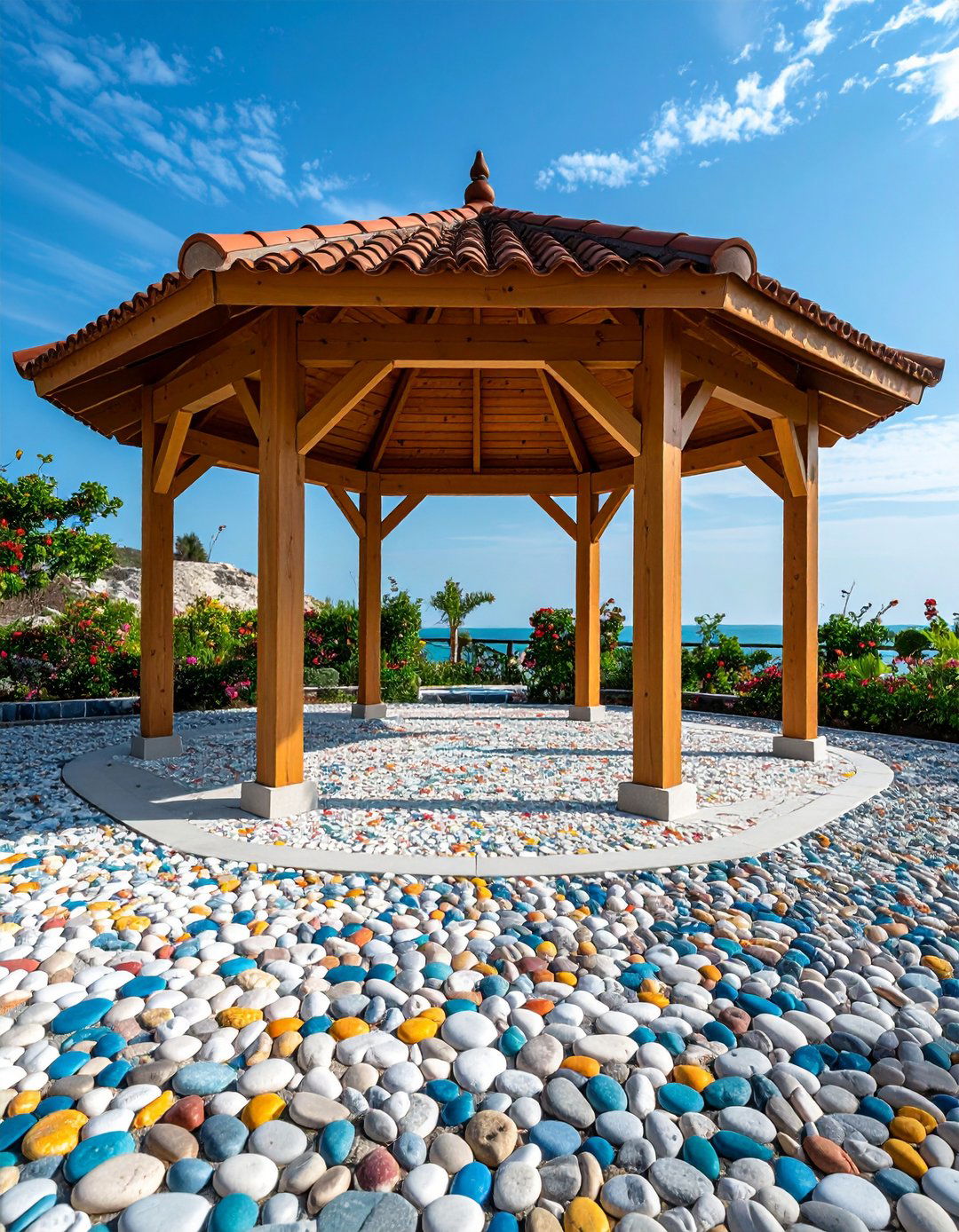
By rinsing the cream layer off fresh concrete, installers reveal pebbles that add pebble-like traction and jewel-tone flair to a gazebo floor. The textured surface hides future scuffs and camouflages small cracks, all while offering excellent slip resistance. Choose decorative aggregates—granite chips, colored glass, or river rock—for custom visuals, and seal with a breathable, non-yellowing guard every three years. Because aggregates occupy much of the wear layer, the slab endures decades of foot traffic before showing wear, making this handsome option surprisingly low maintenance.
17. Modern Aluminum Deck Gazebo Floor
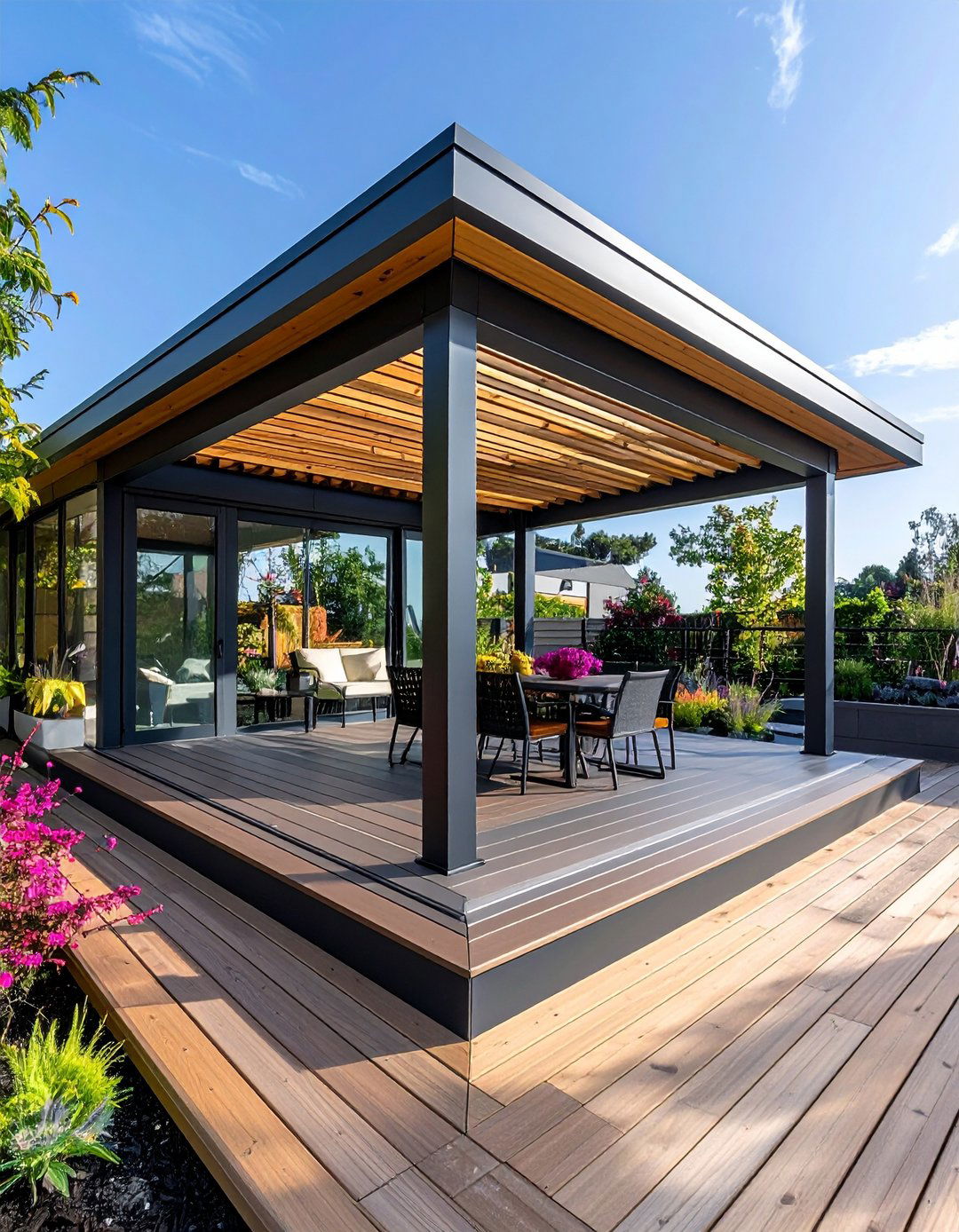
Powder-coated aluminum decking panels lock together to form a watertight gazebo floor that will never warp, rot, or host termites. Systems from specialty manufacturers boast class-A fire ratings and cool-to-touch surfaces even on scorching afternoons, thanks to heat-reflective pigments. Hidden fasteners clamp boards to joists, and integrated drip channels create a dry storage area beneath elevated gazebos. Anodized finishes resist scratches, and light soap cleans most stains. Though the look skews contemporary, pairing it with timber posts or cable rails tempers the vibe for mixed-material elegance.
18. Live-Edge Wood Round Gazebo Floor
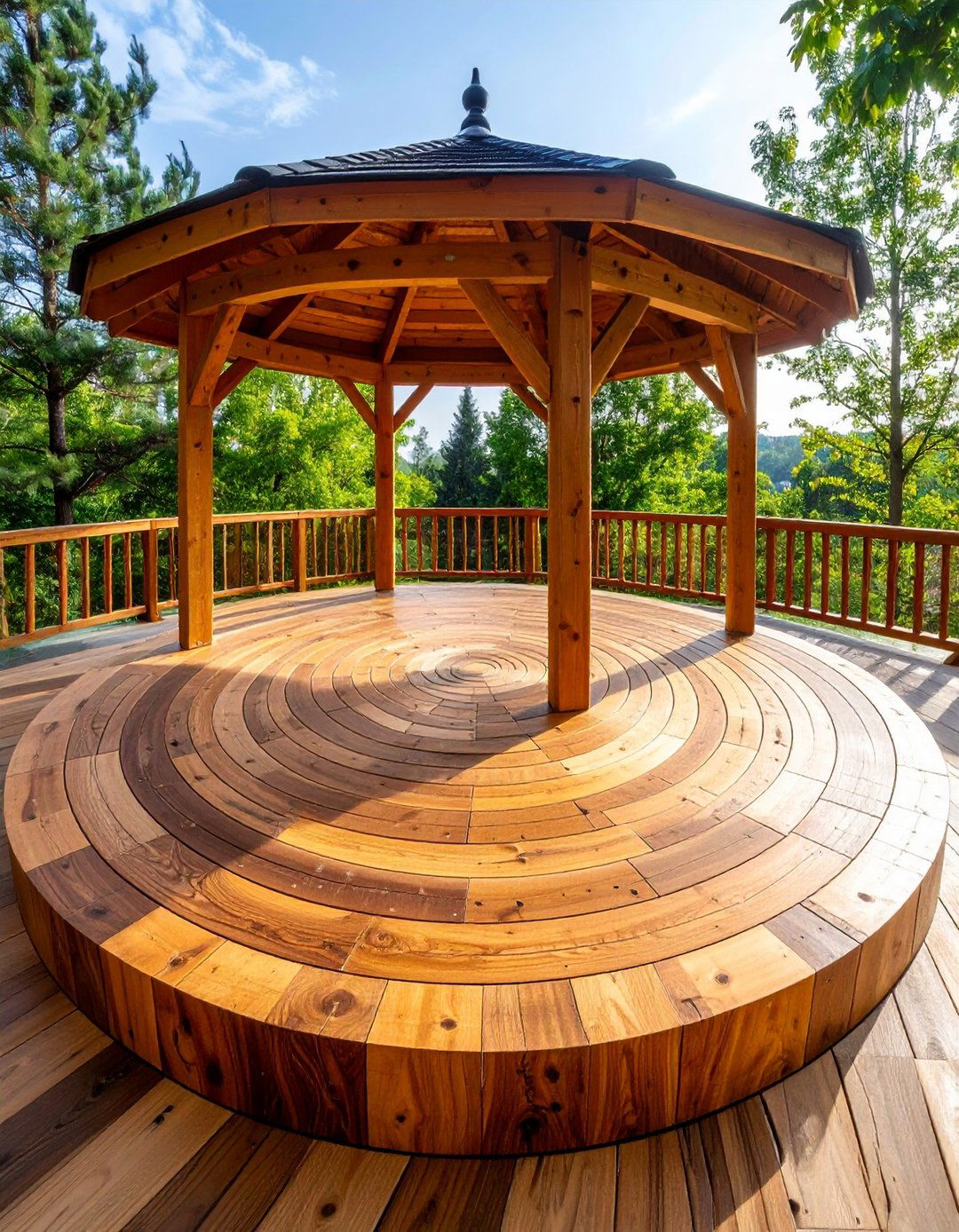
For a woodland fairy-tale aesthetic, cut hardwood logs into 2-inch slices and set them like cookies in sand or mortar. The concentric rings create a mesmerizing pattern and repurpose storm-downed trees into a whimsical gazebo floor. Treat each round with borate and exterior oil to deter insects, then tamp smaller gravel between discs for drainage and stability. Expect natural checks and patina over time—a desirable part of the design’s cabin-like charm. Replace individual rounds as needed; the floor grows more characterful with each swap.
19. Mosaic Tile Gazebo Floor Accent
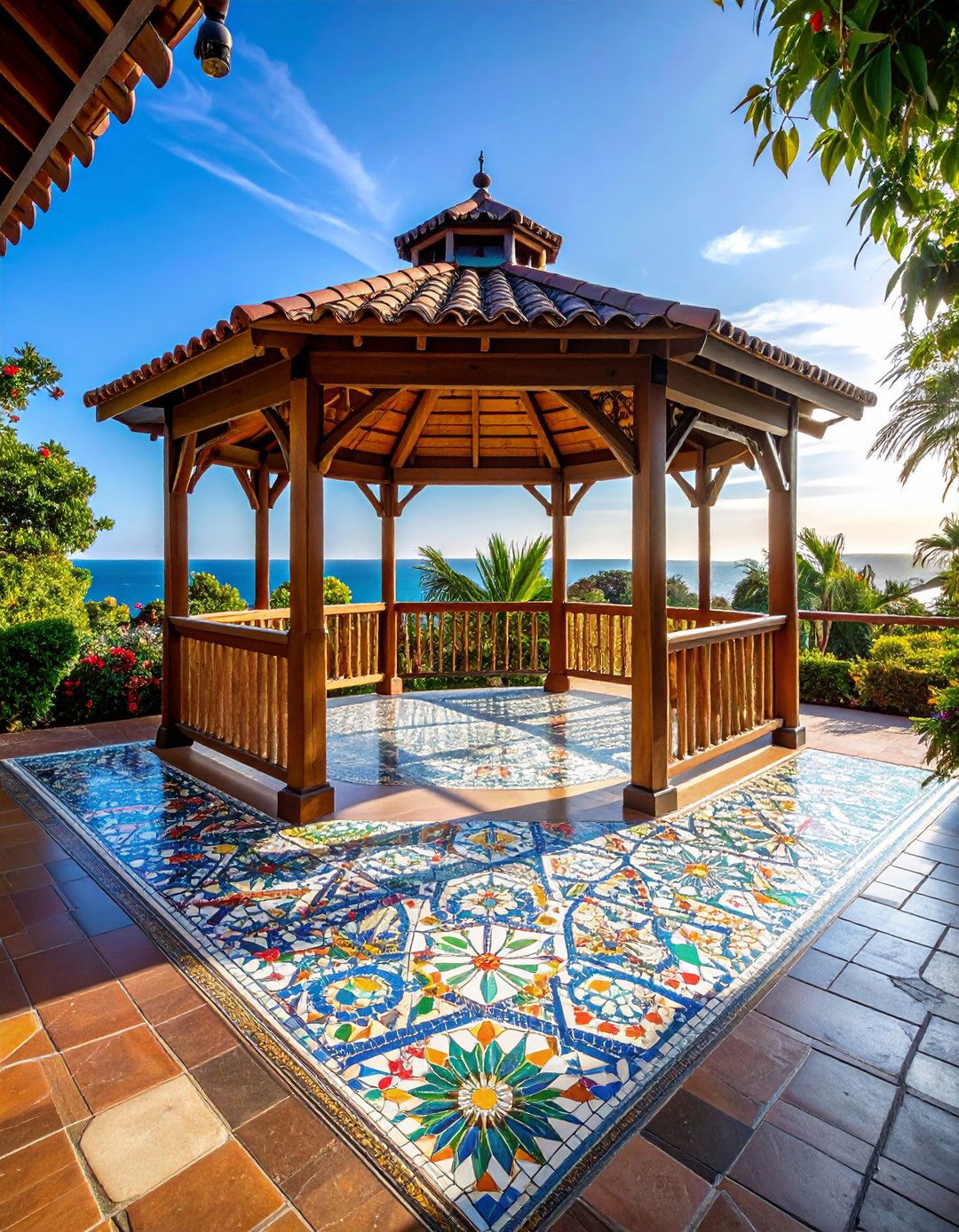
Dial up artistry by laying frost-proof mosaic tiles in geometric or botanical motifs under a central table or along the entry band. Handmade or porcelain pieces withstand freeze-thaw cycles when bedded into flexible exterior thin-set and grouted with epoxy for stain immunity. A monochrome motif can echo the gazebo’s trim color, while multihued shards create a jewel-box focal point. Seal matte tiles for easier cleanup of sap or pollen. The durable glaze needs only gentle sweeping, letting the gazebo floor double as a statement artwork underfoot.
20. PVC Perforated Drainage Tile Gazebo Floor
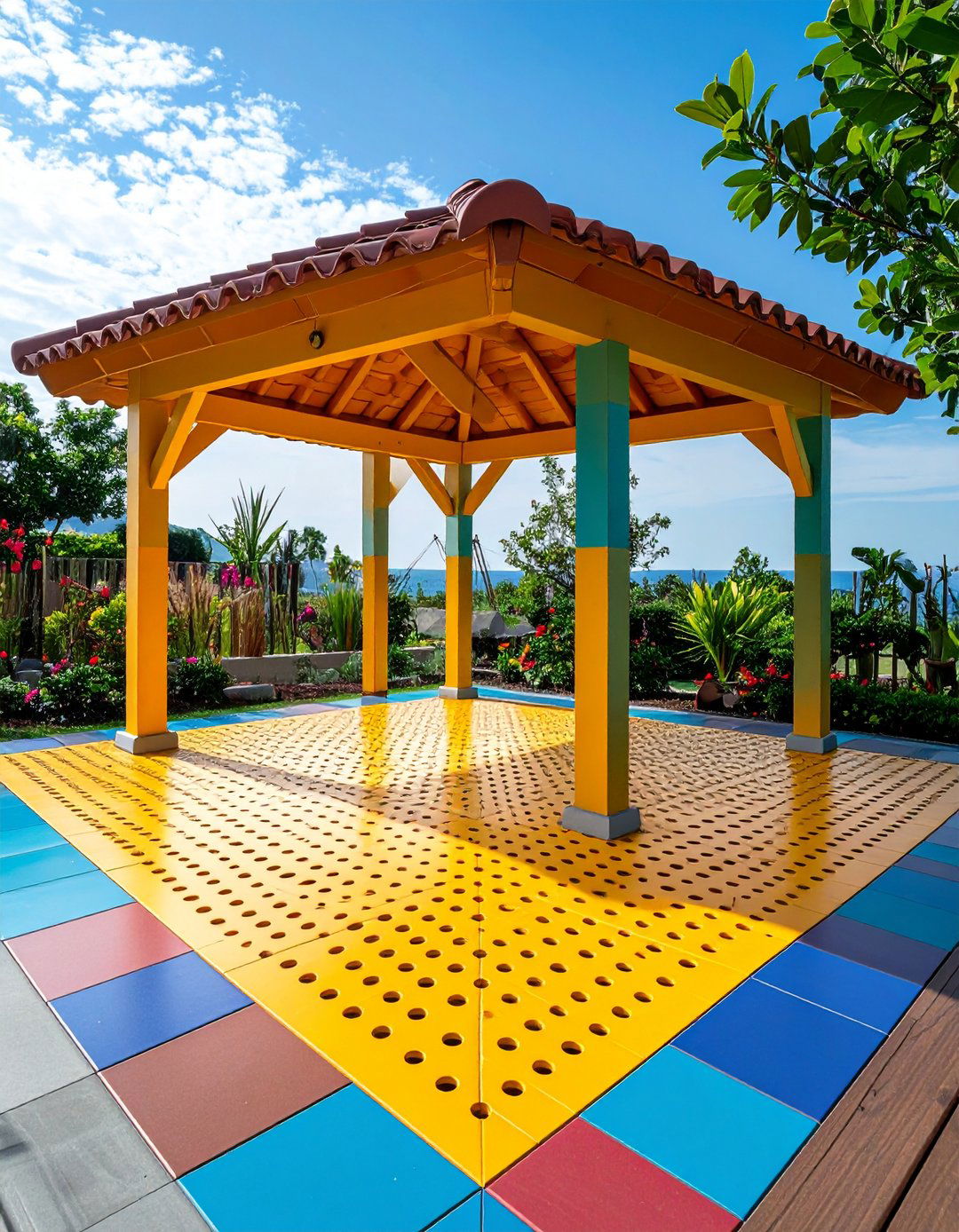
Lightweight PVC tiles with raised drainage channels click together to form a cushioned, non-slip gazebo floor that drains splashy pool water or sudden downpours in seconds. The perforations prevent puddles and mildew, making them ideal for lakeside or spa-side pavilions. Tiles cut with scissors for custom shapes, and bright color choices help zone activity areas. Because they lift free for cleaning, you can spray the entire floor from both sides—a bonus in sandy or leaf-littered settings. UV-stable additives keep hues from chalking, ensuring the gazebo stays vibrant season after season.
Conclusion:
Whether you crave the heritage of brick, the eco-benefits of bamboo, or the bulletproof longevity of aluminum, a gazebo floor can be far more than an afterthought. Each of these 20 ideas balances beauty with performance, showing how thoughtful material choices solve drainage, maintenance, and safety challenges while expressing personal style. Use the concepts singly or combine them—porcelain under dining chairs, turf for a lounge nook, permeable pavers around the perimeter—to craft a floor that invites you outdoors and stands up to the elements for years of shaded relaxation.


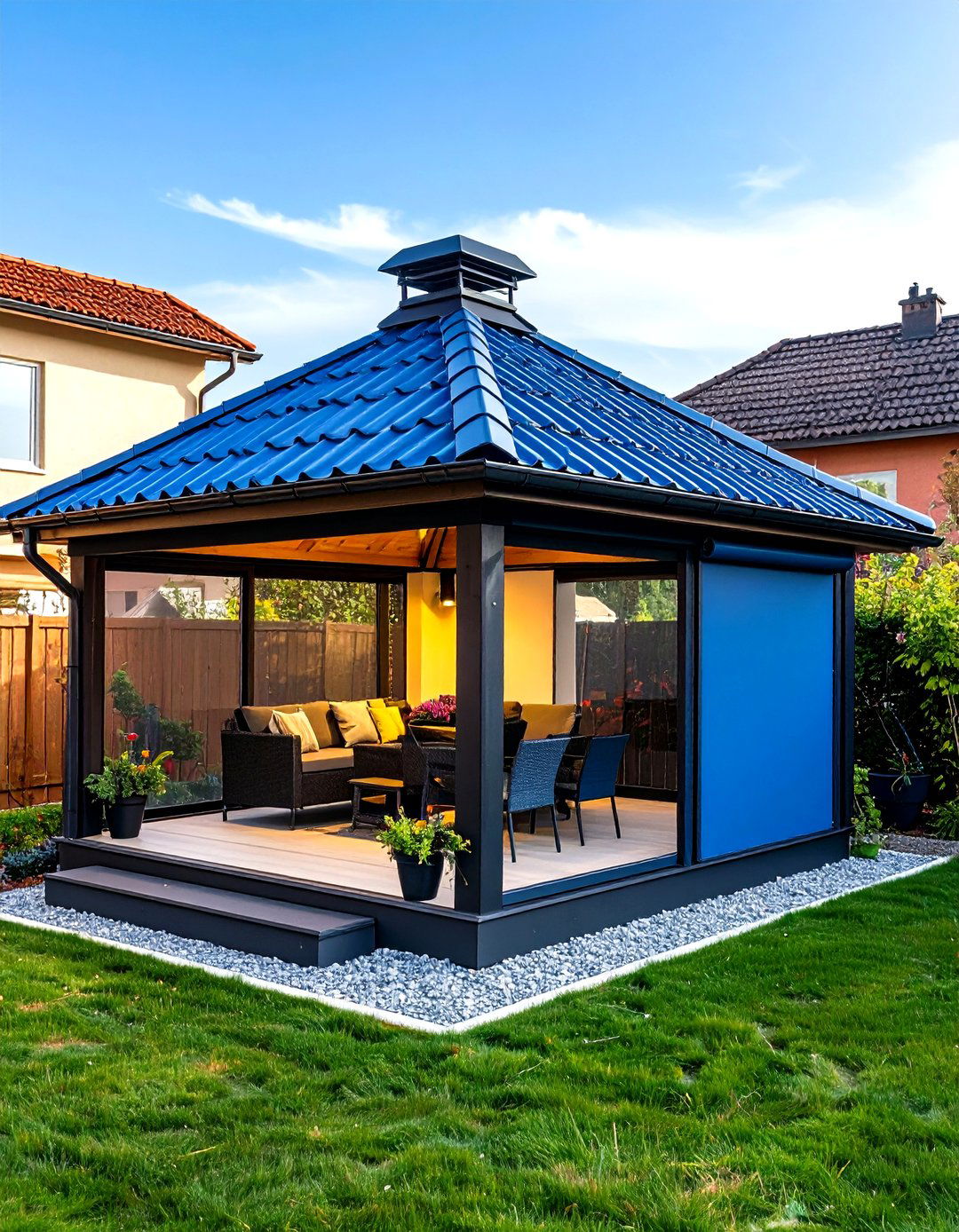
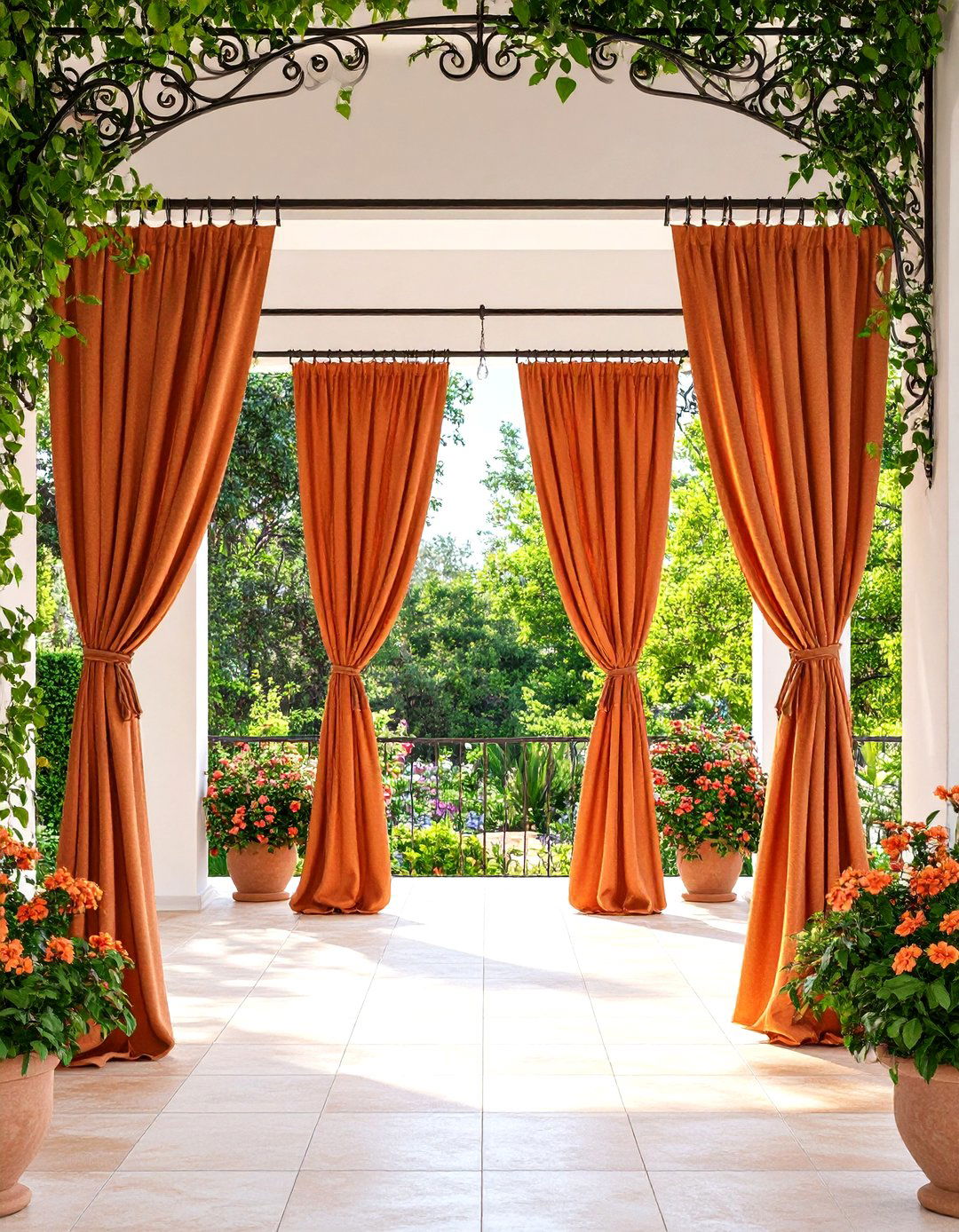
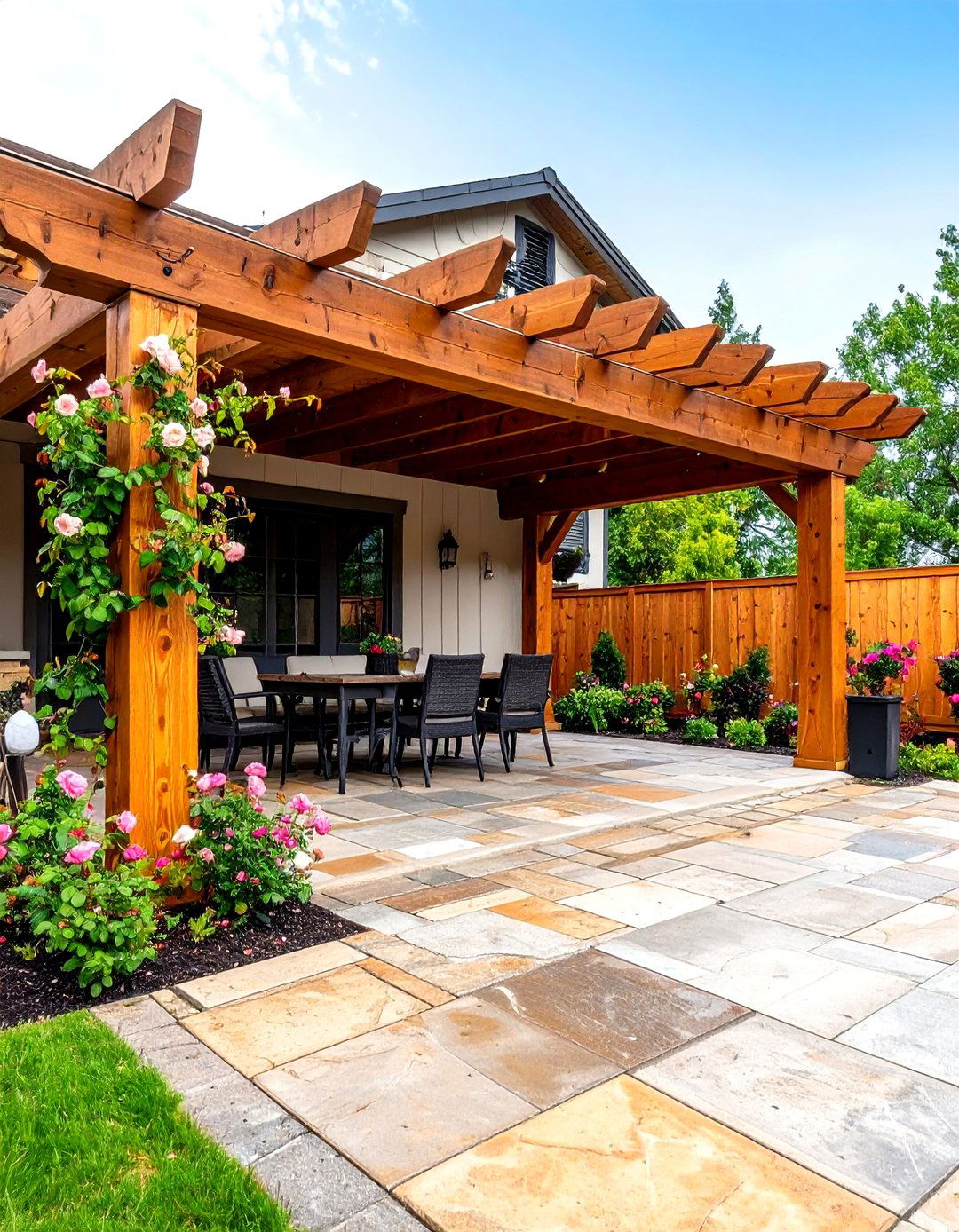
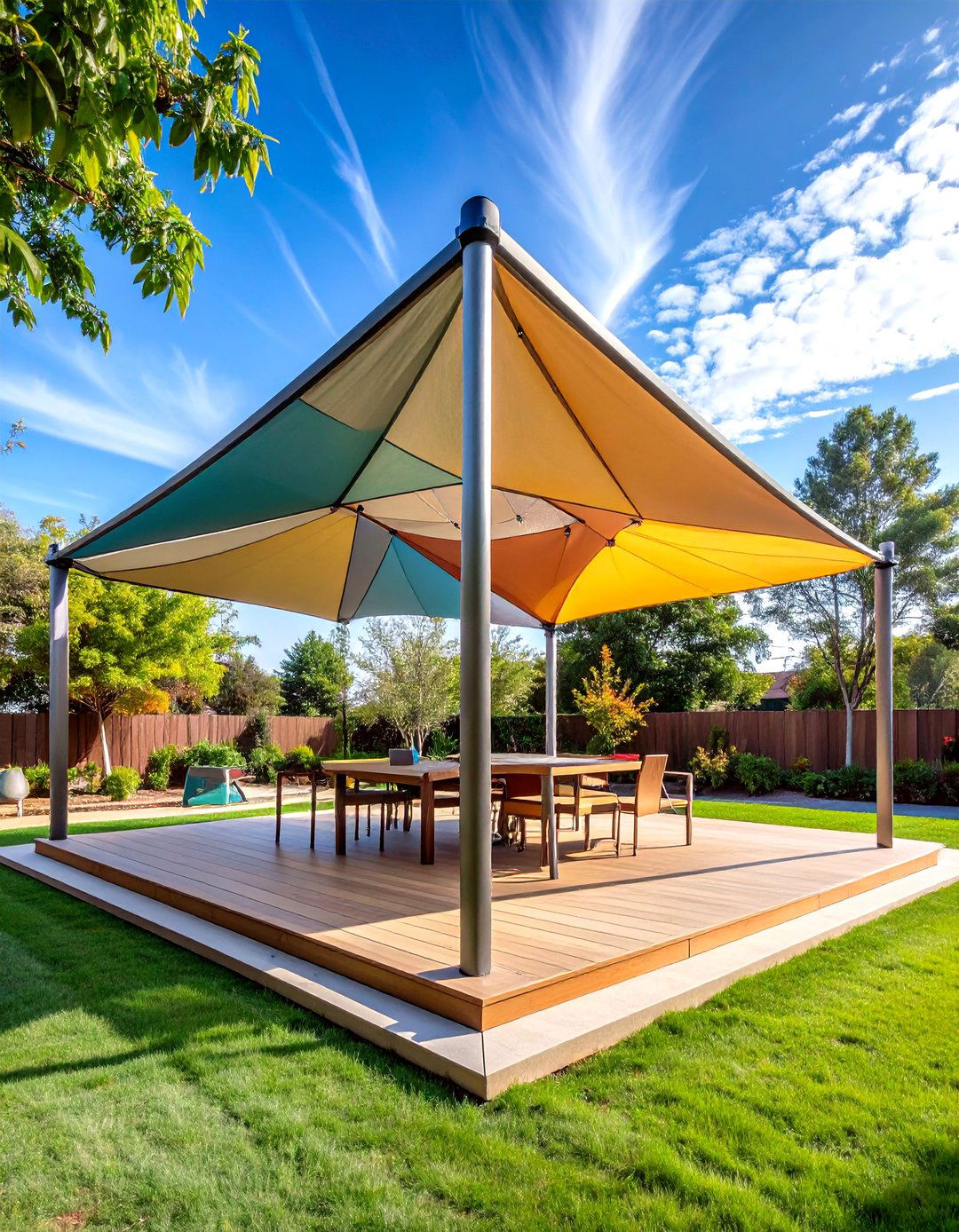
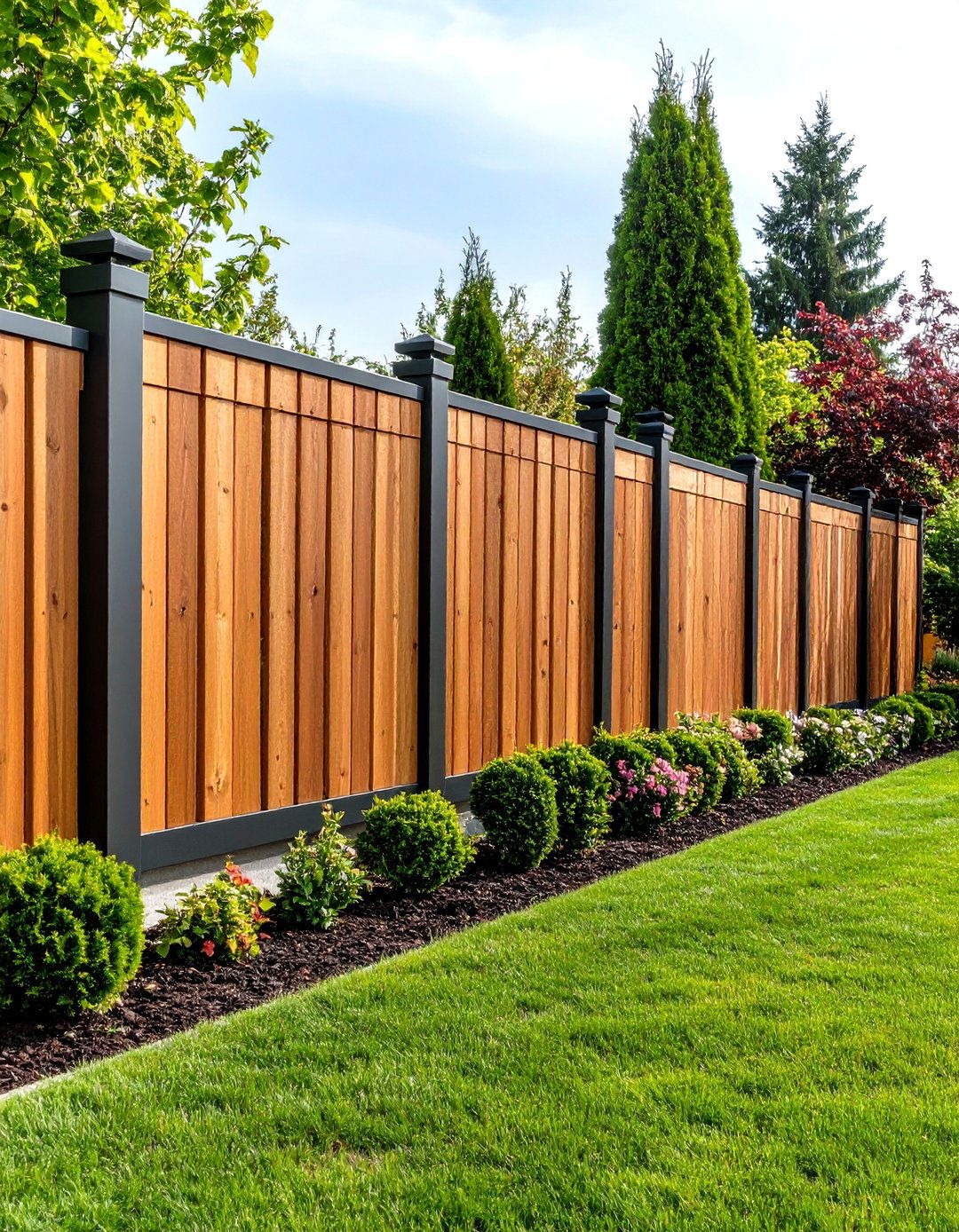
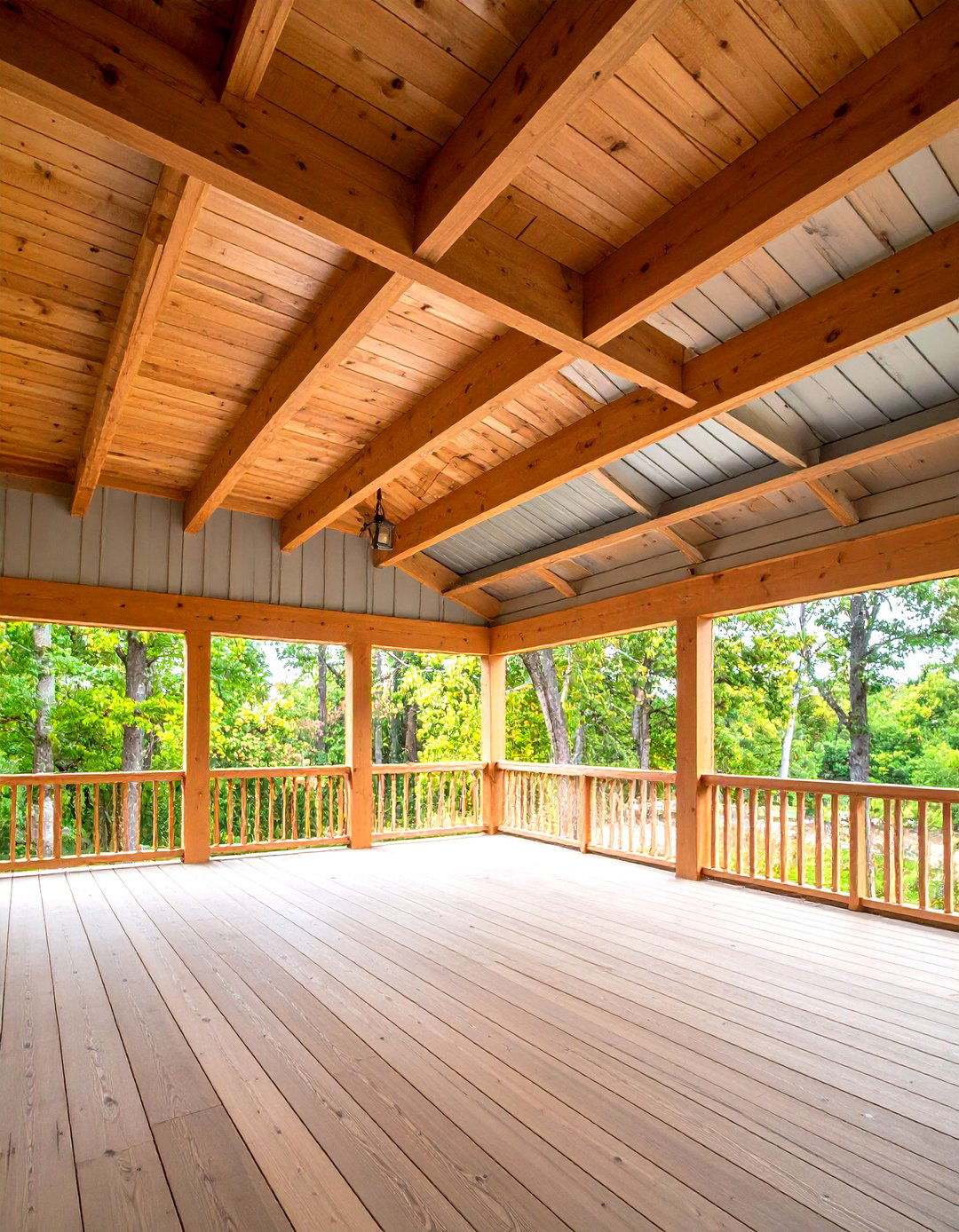
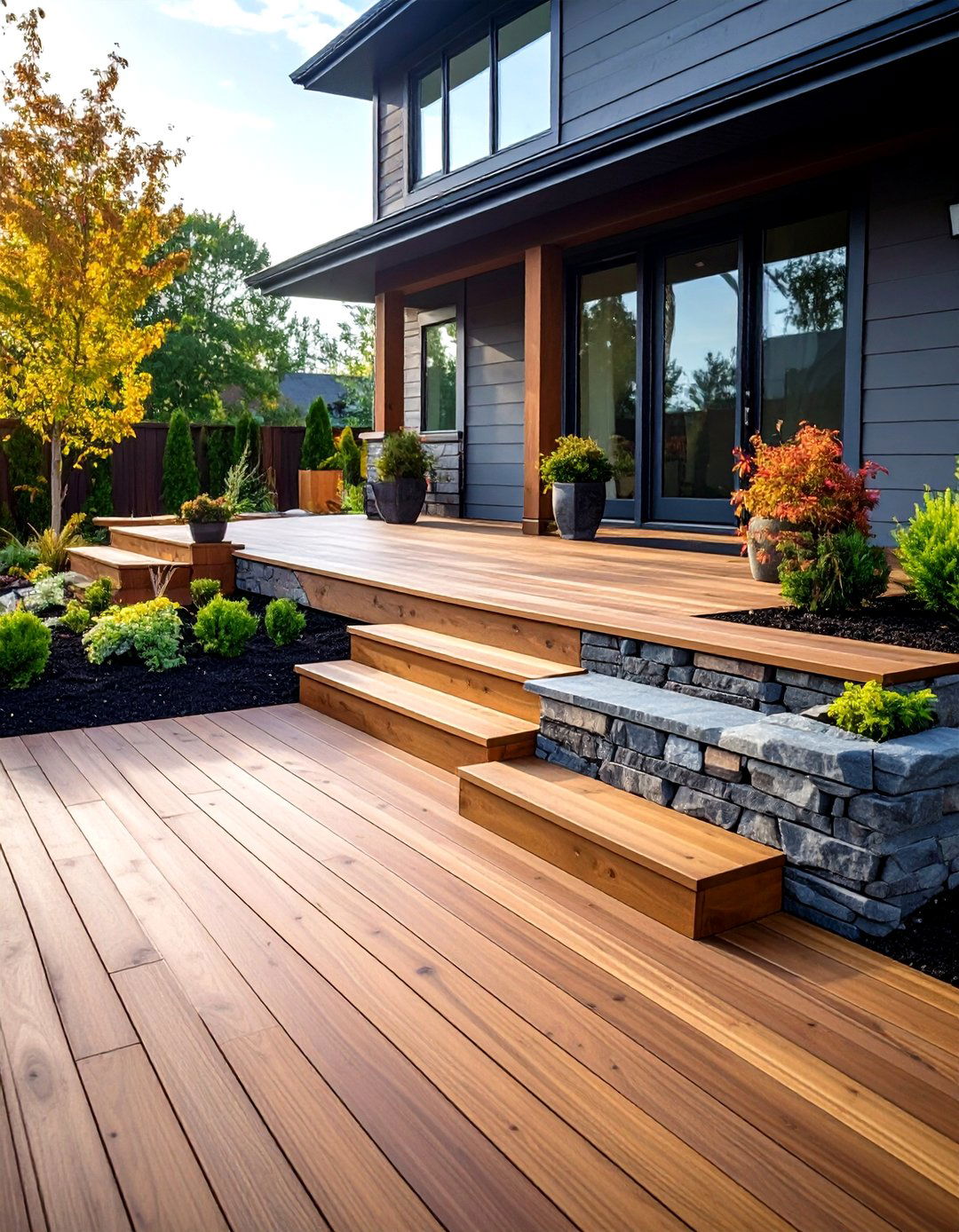
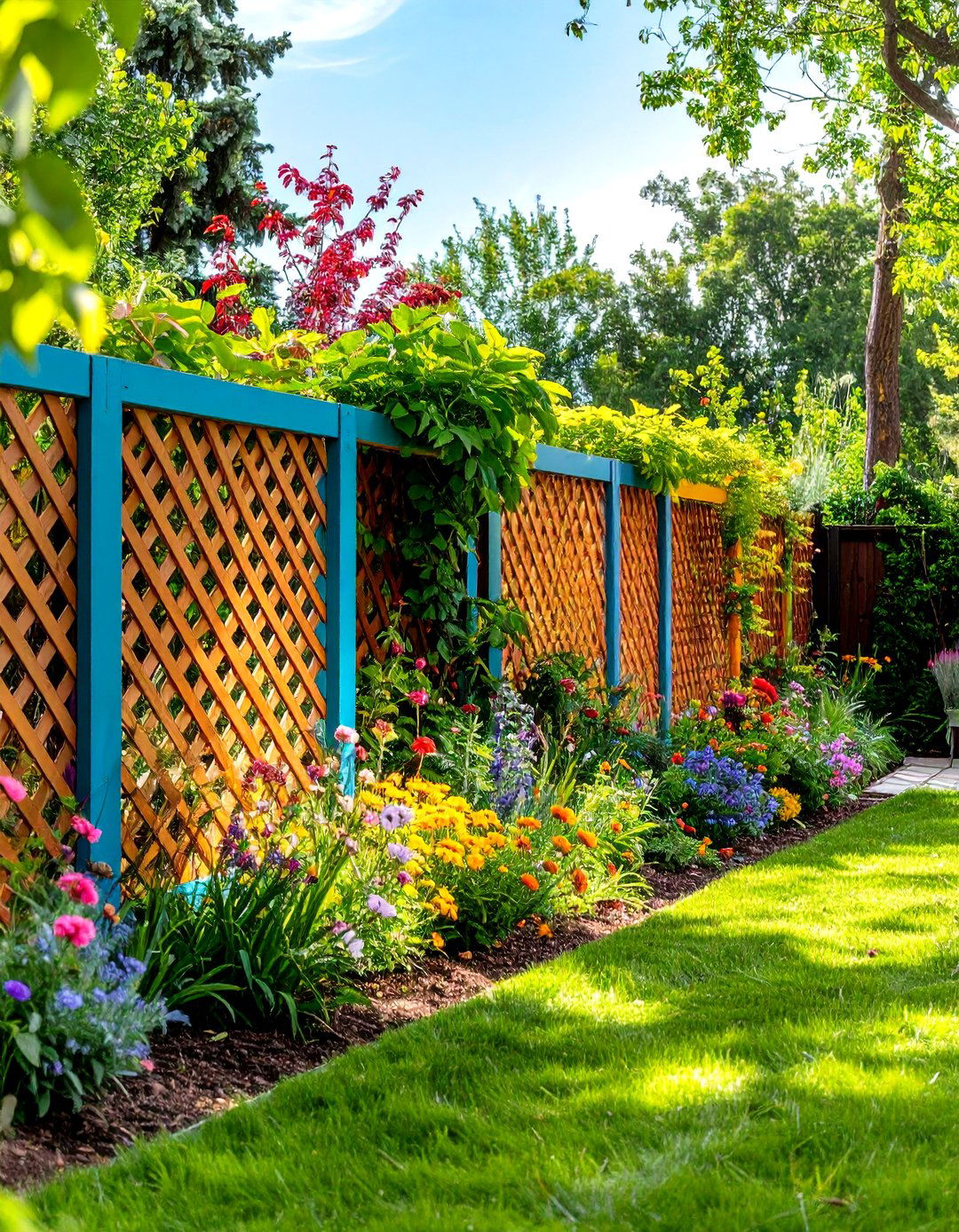

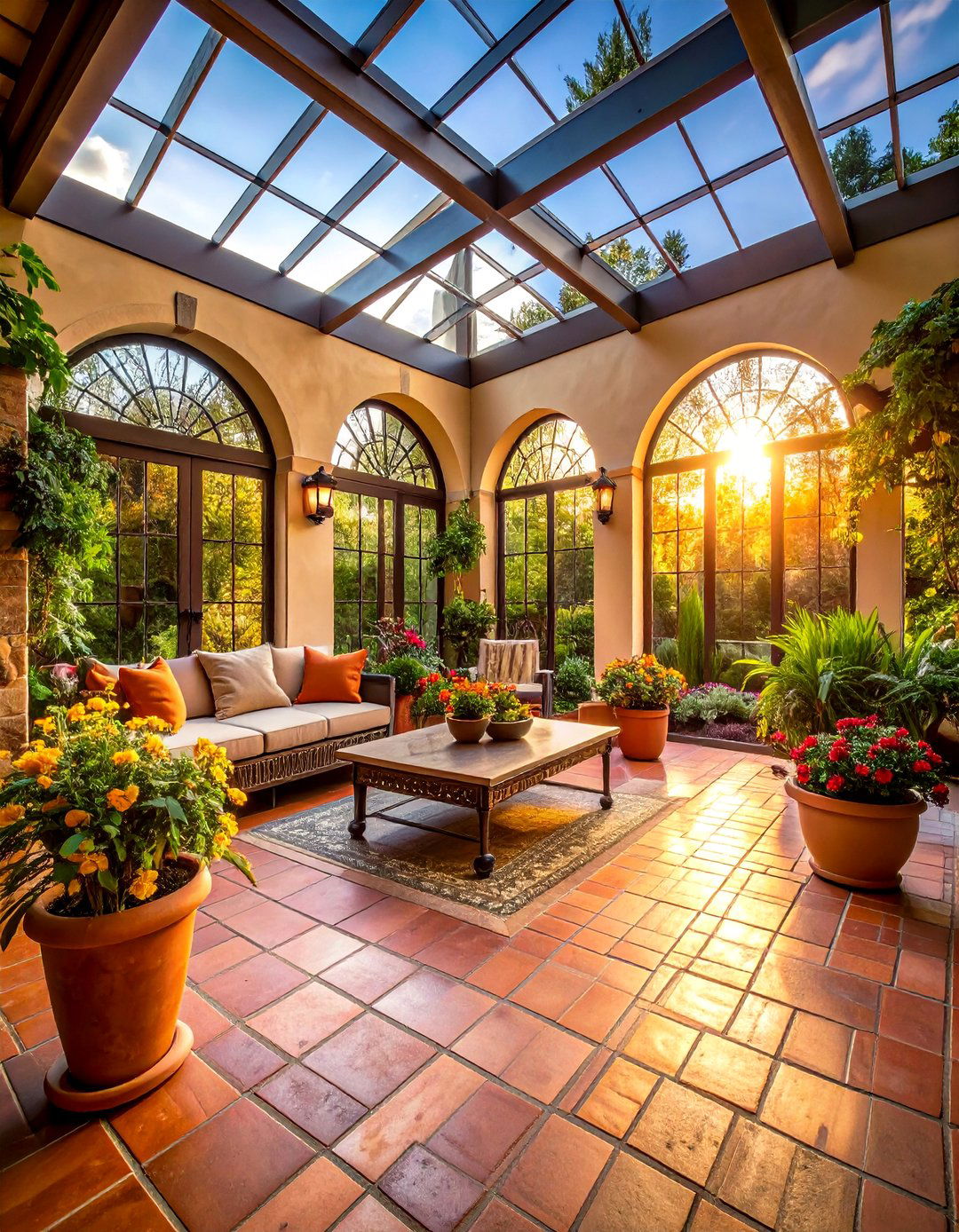
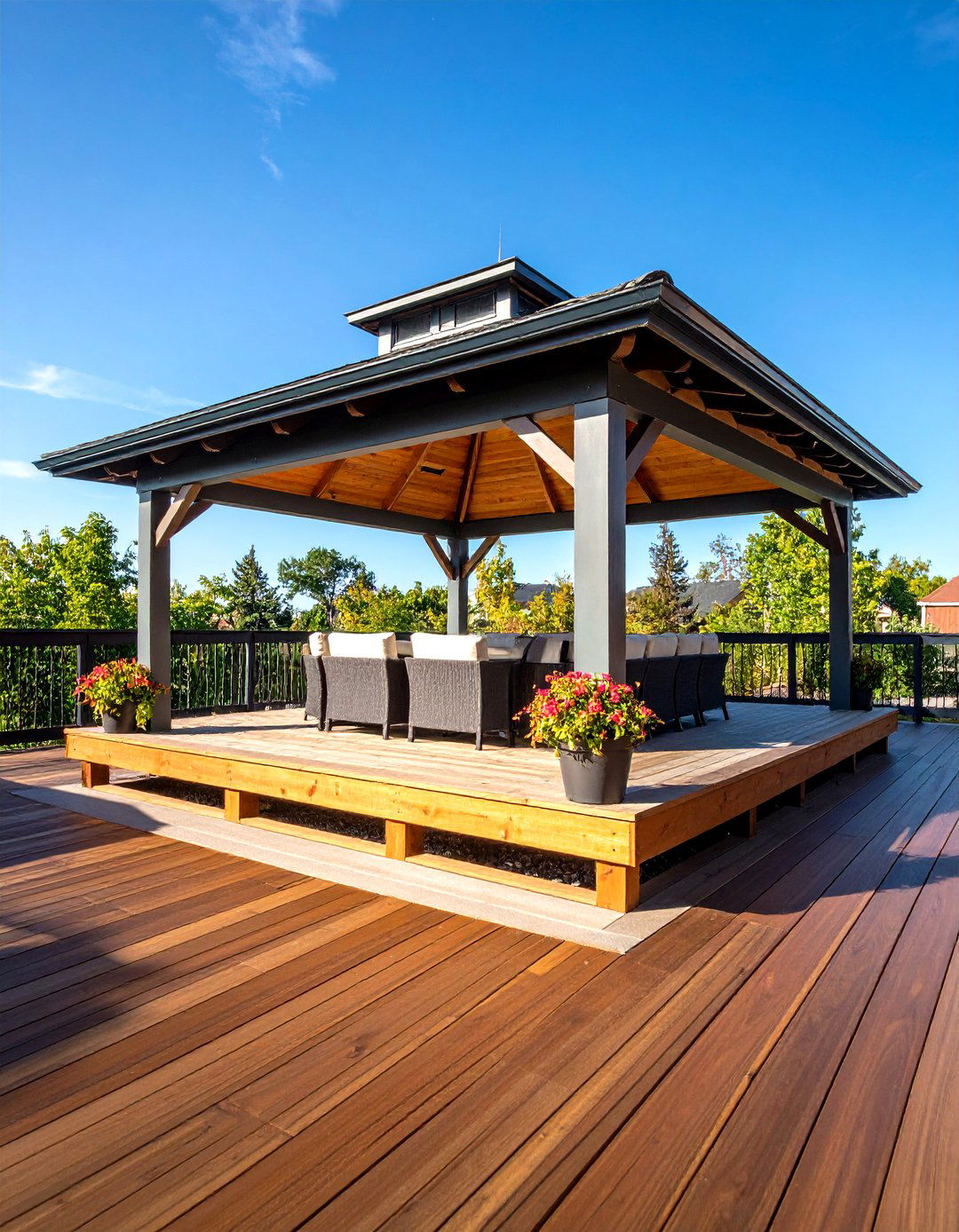
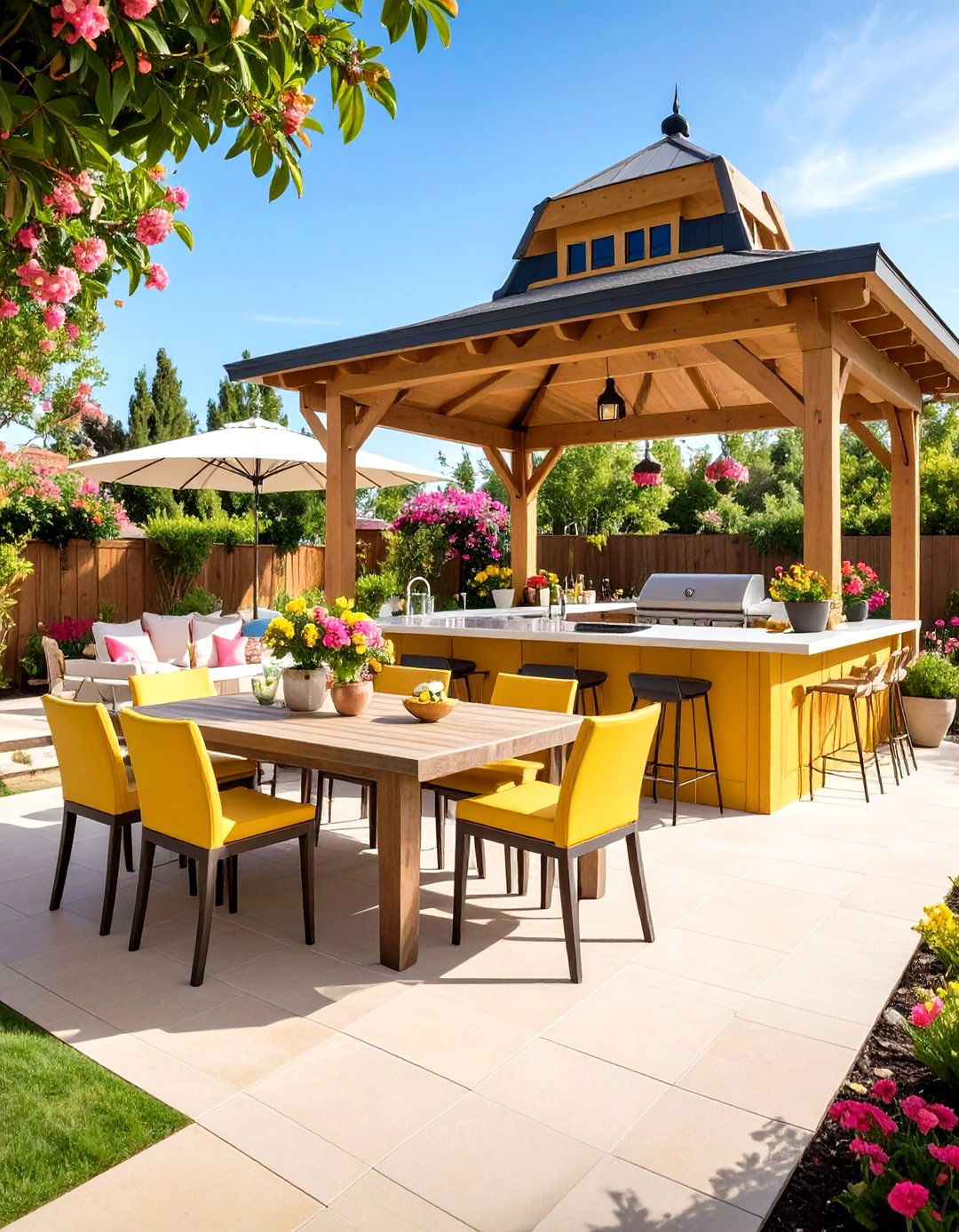
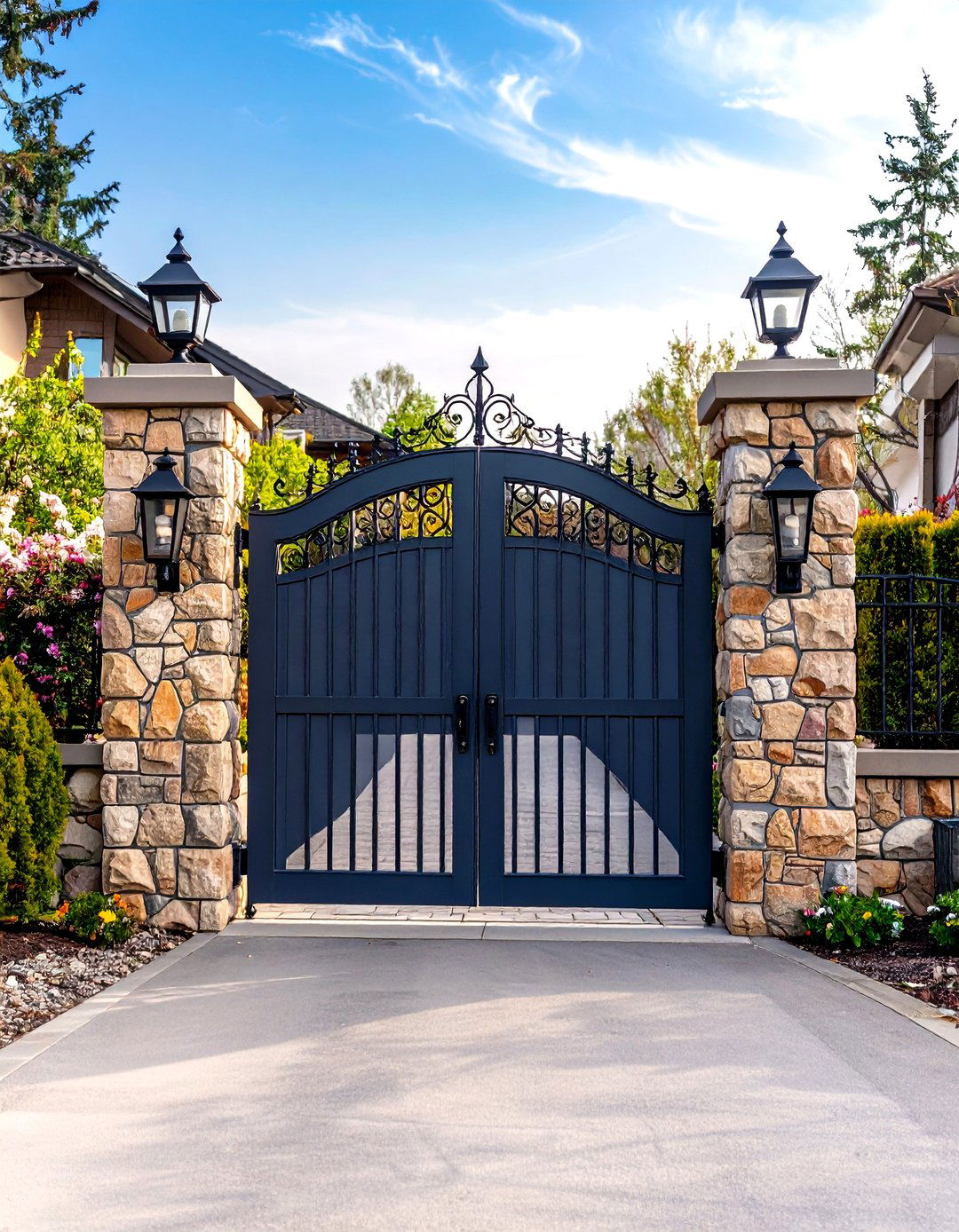
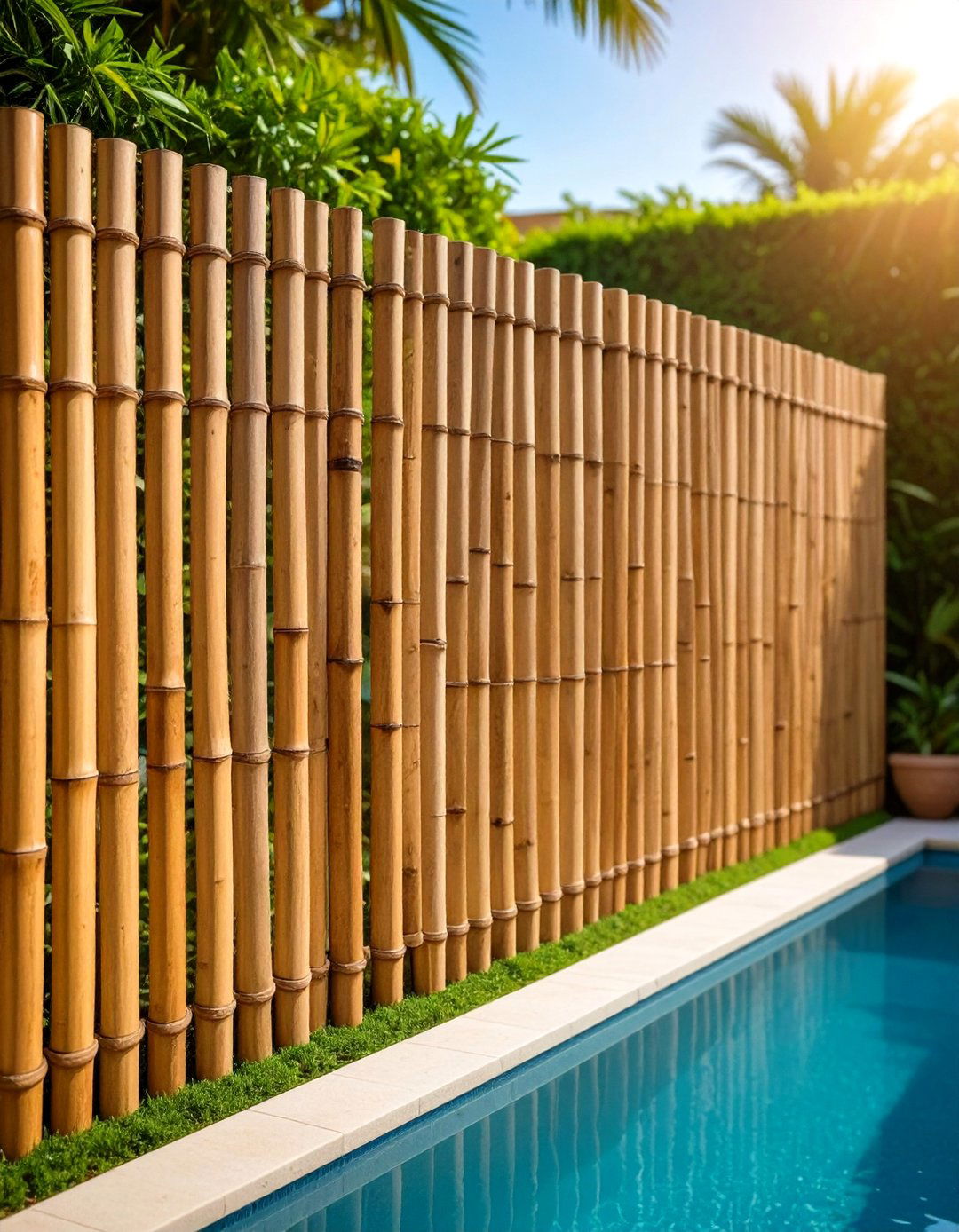
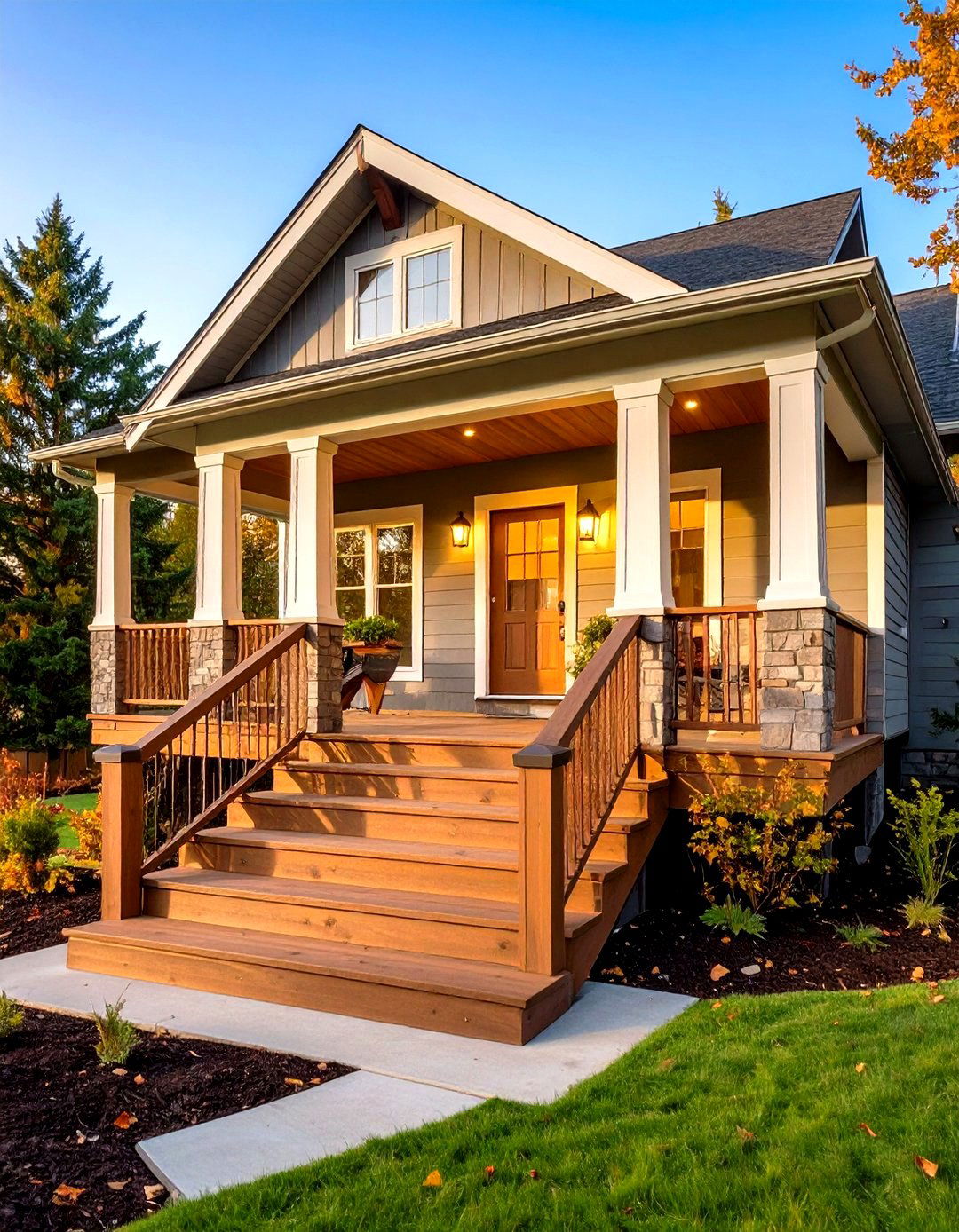
Leave a Reply